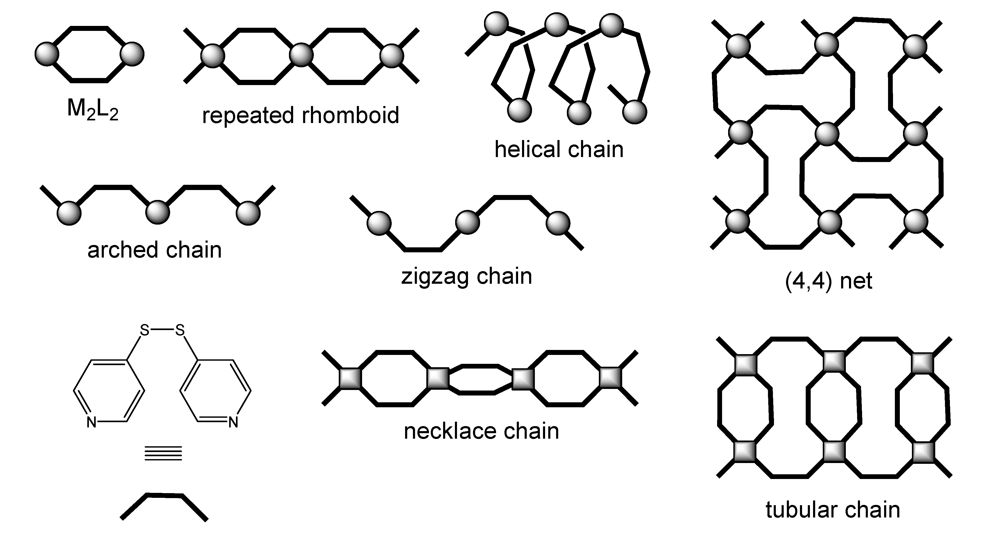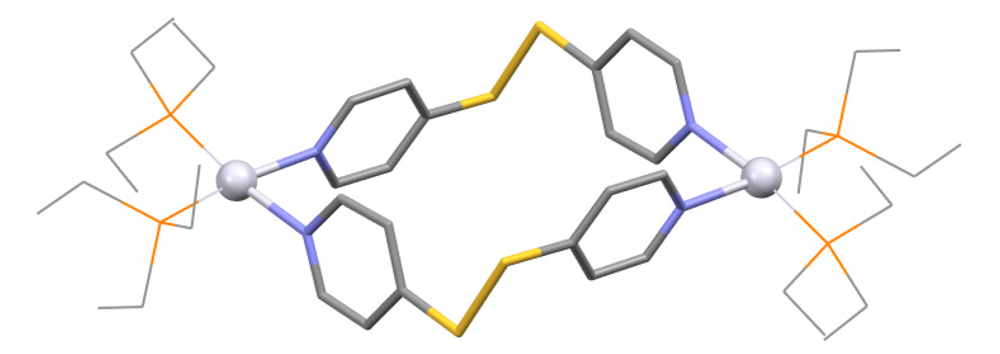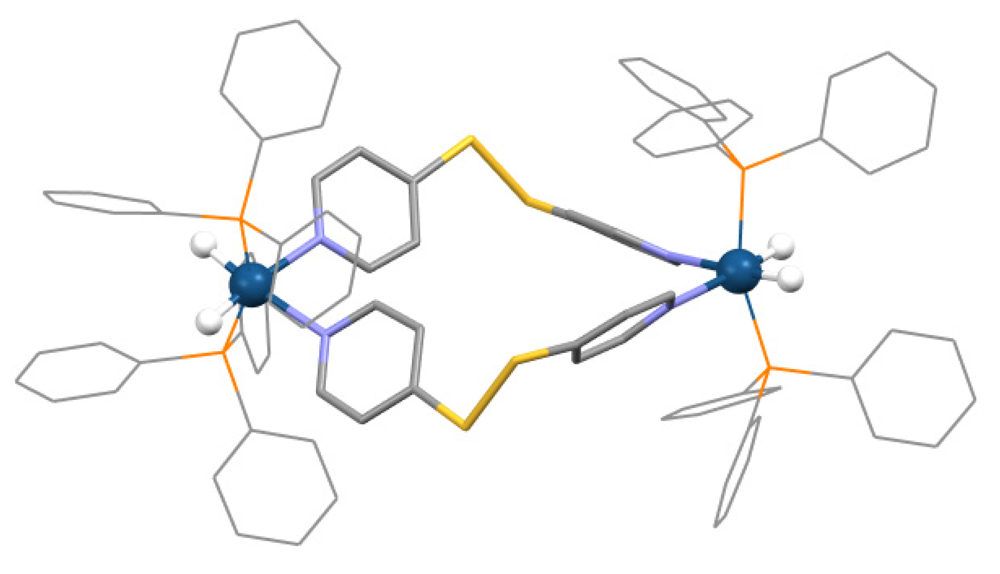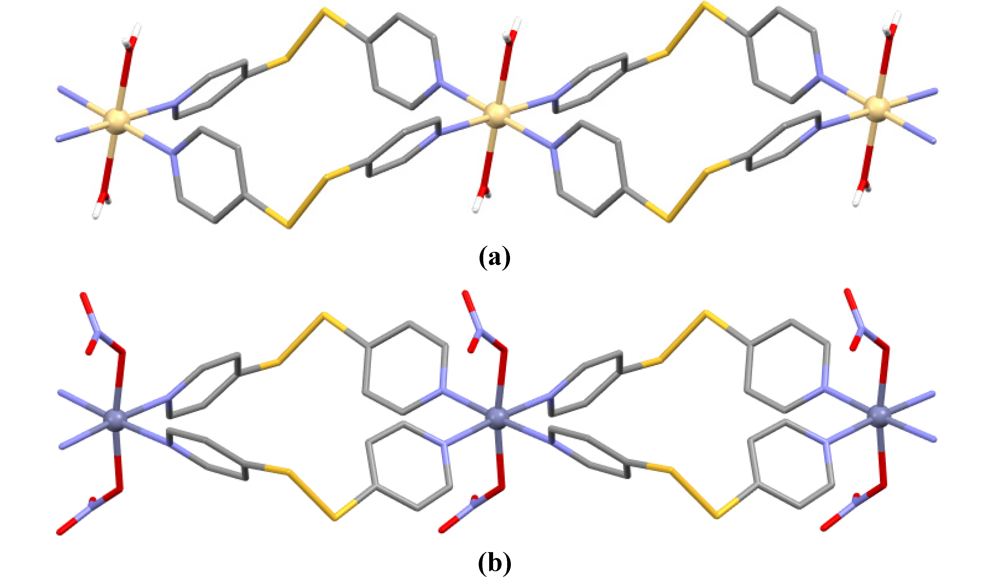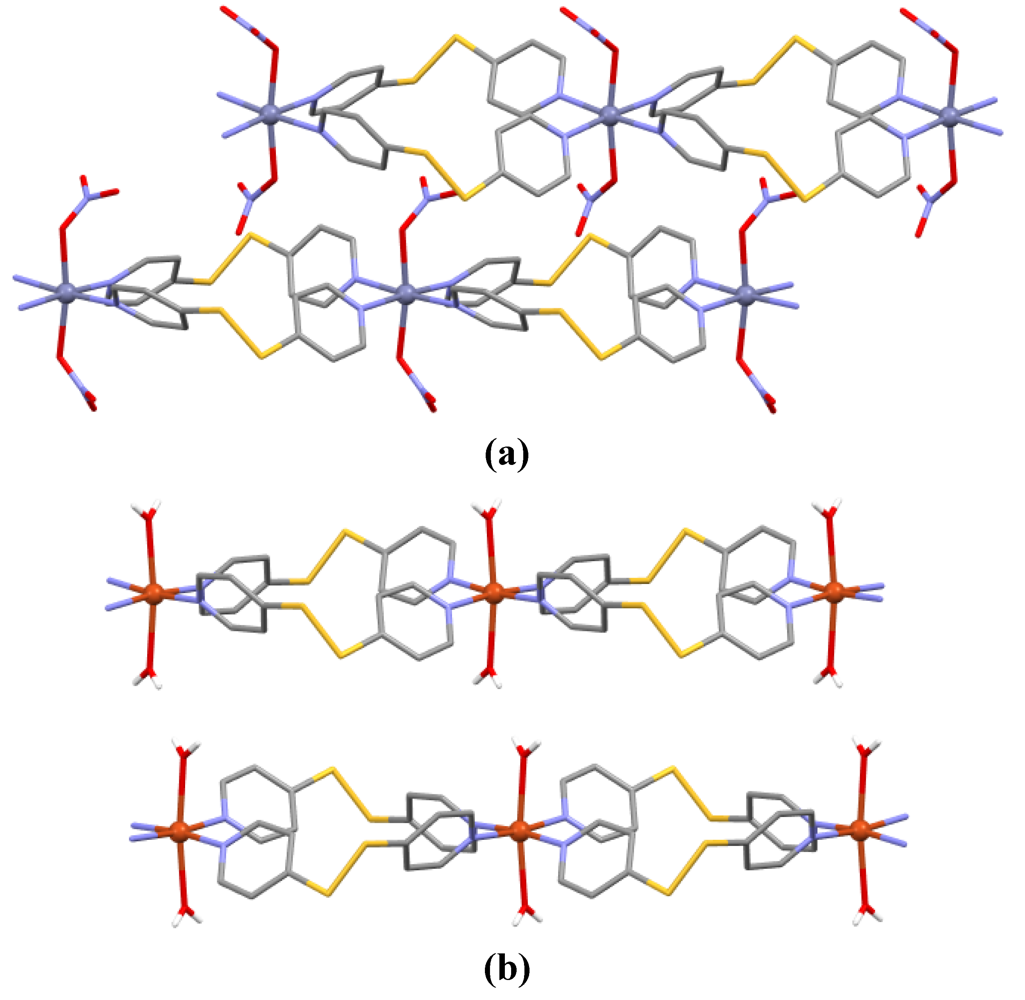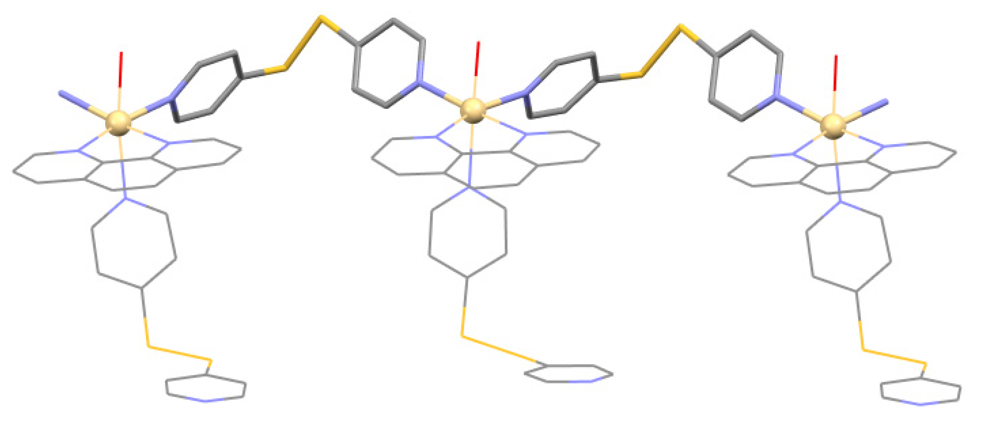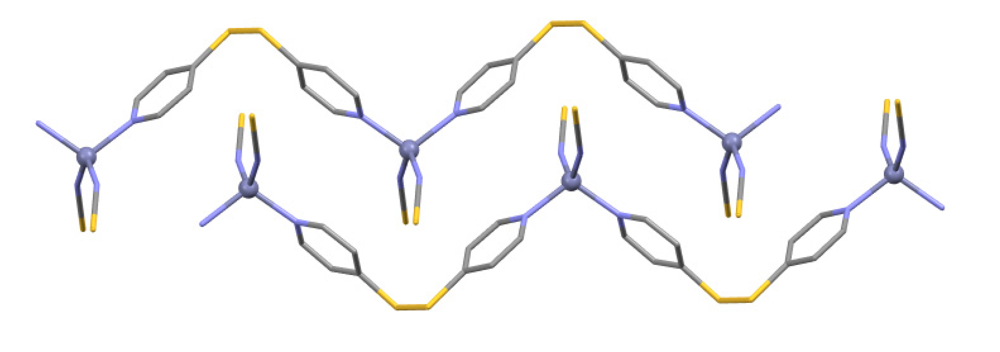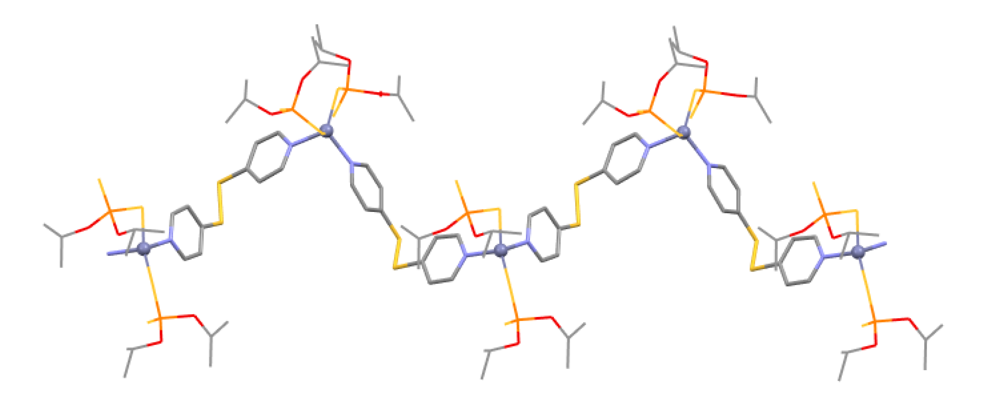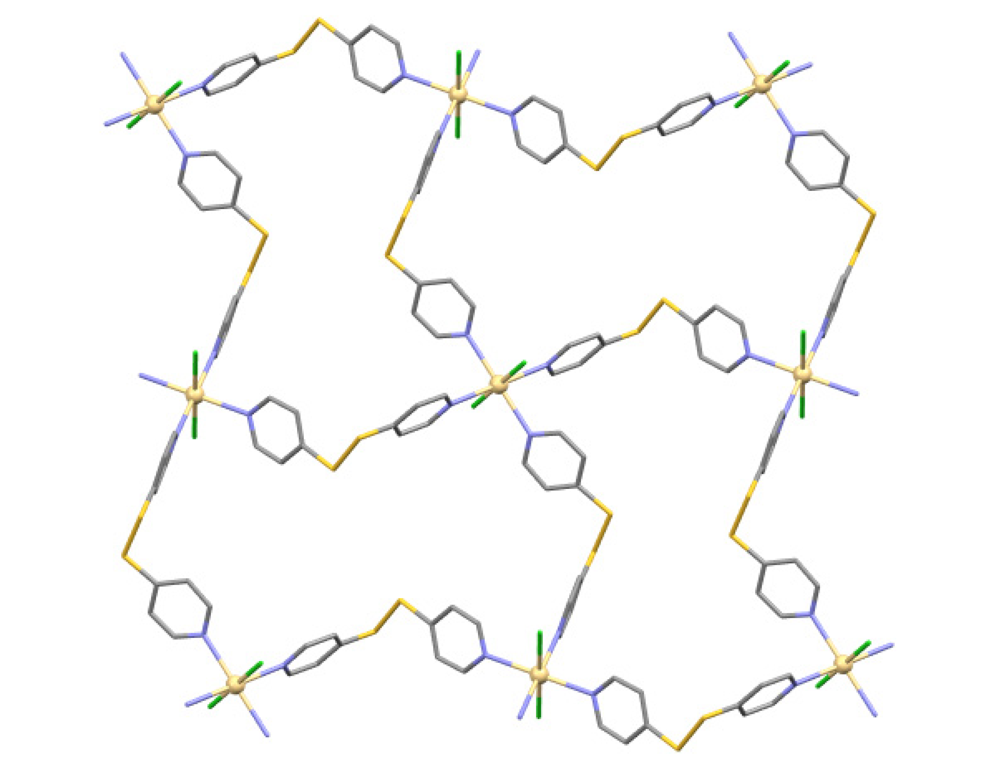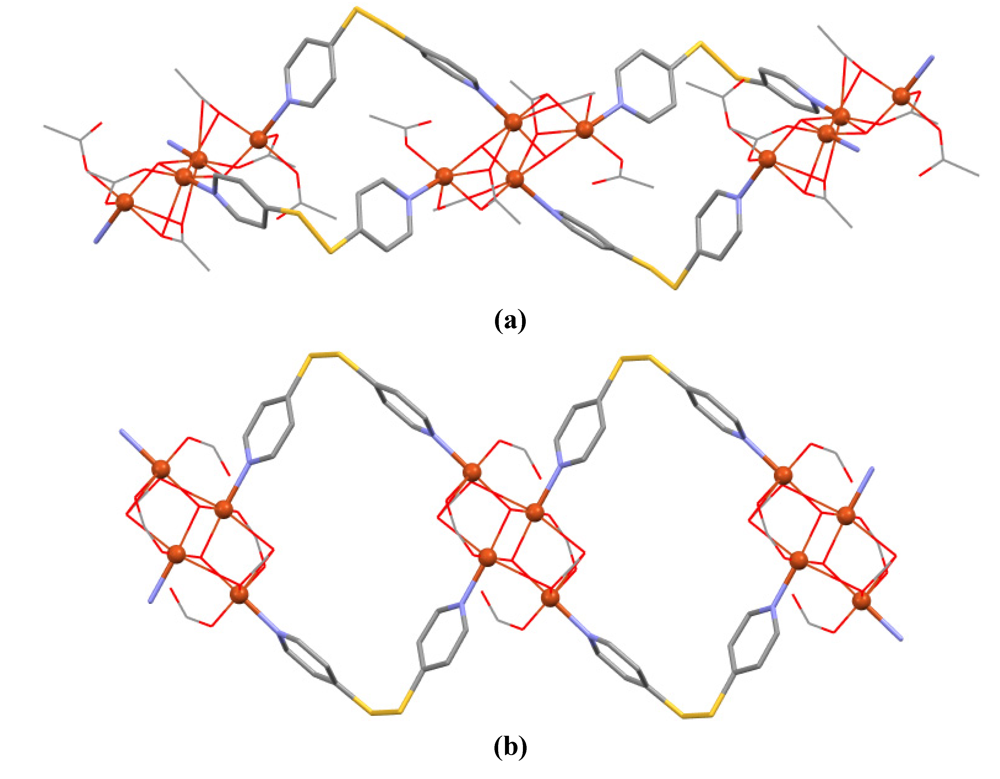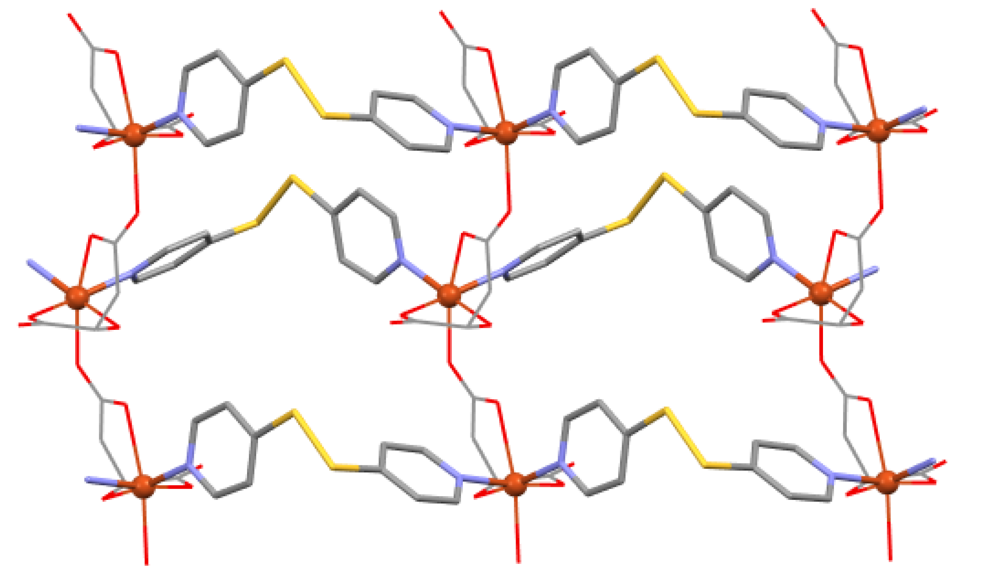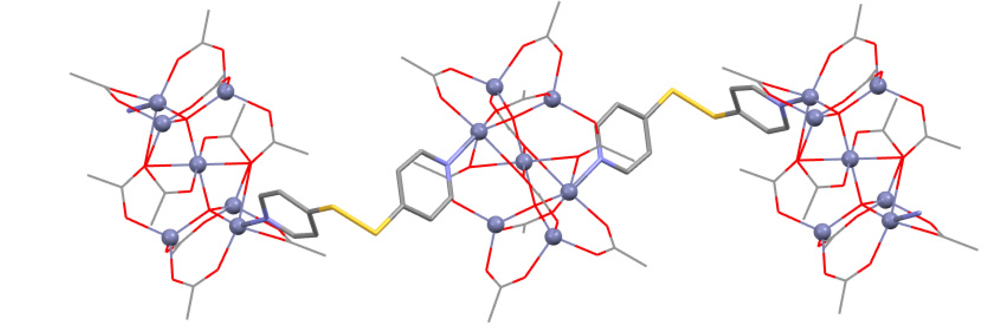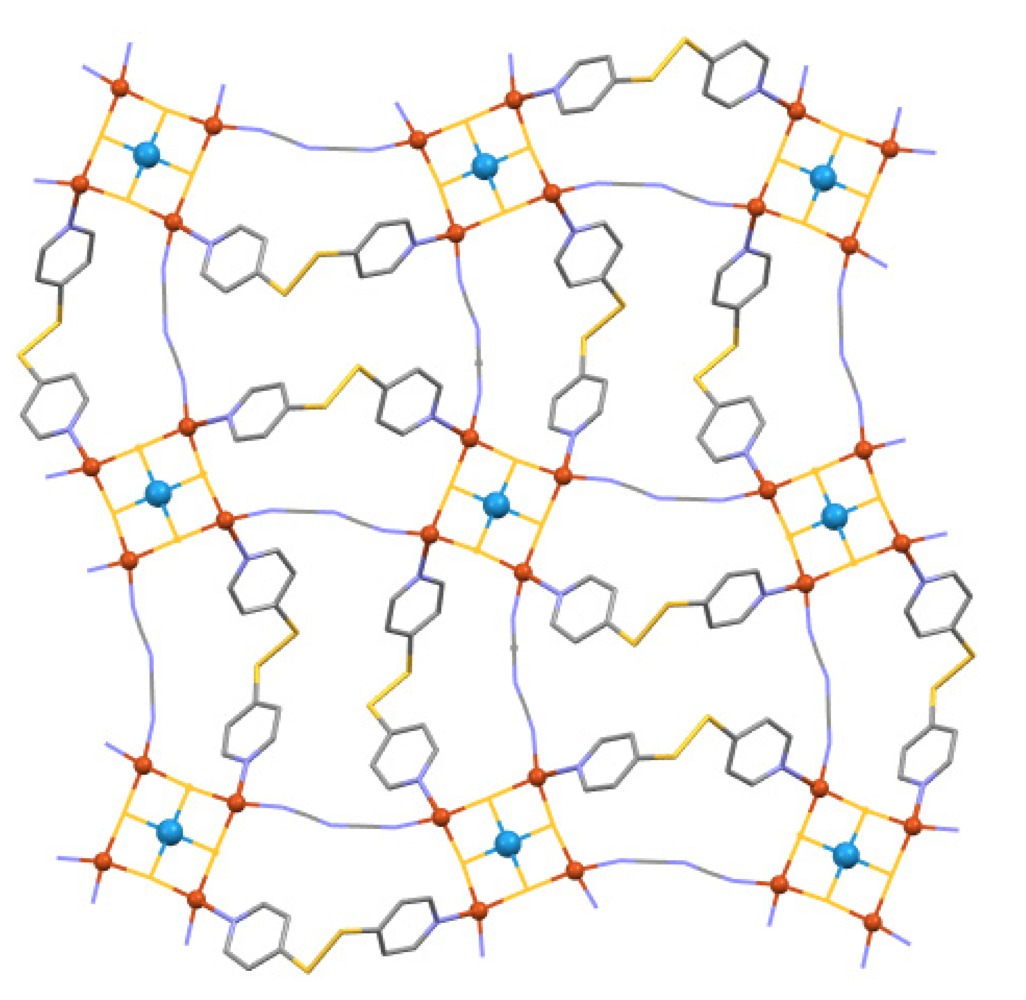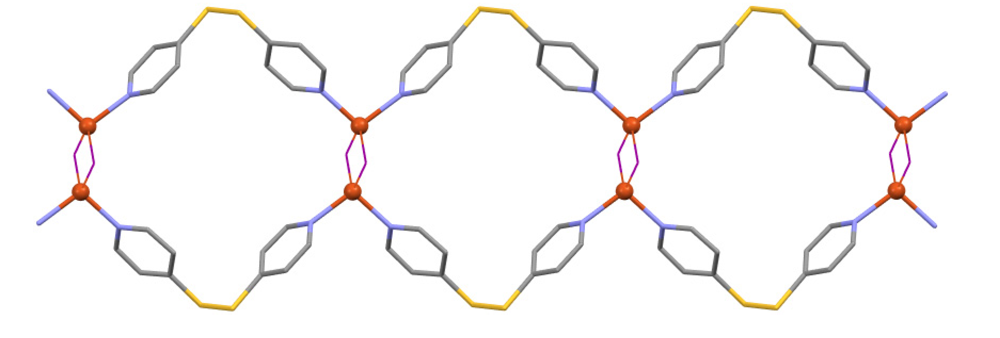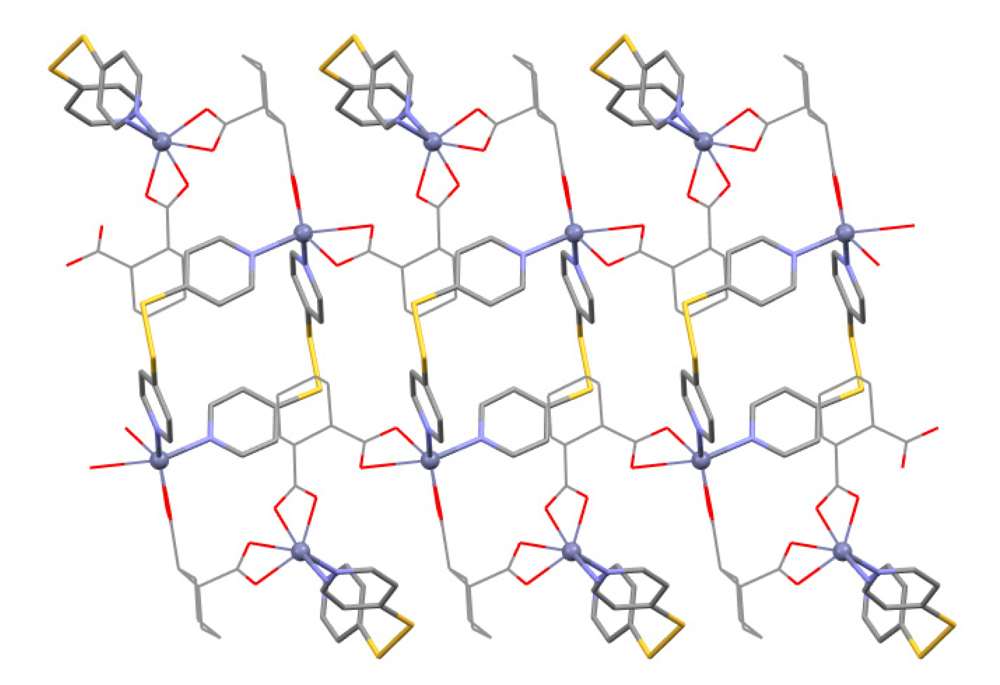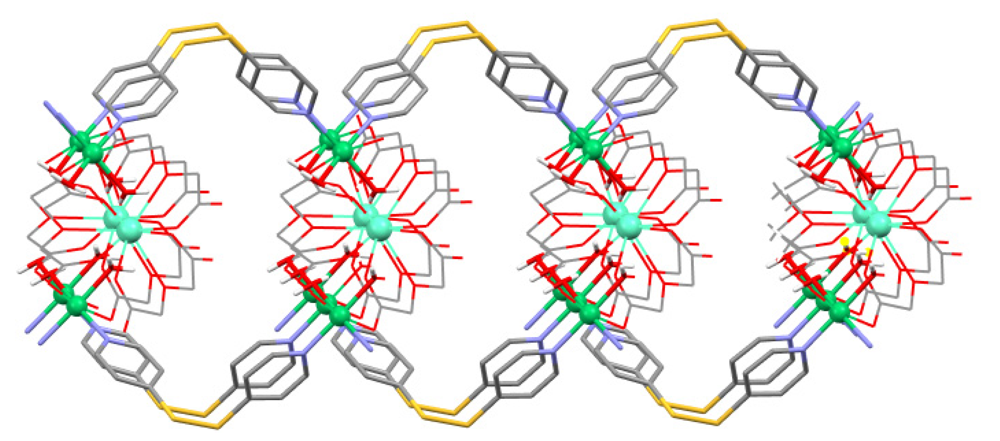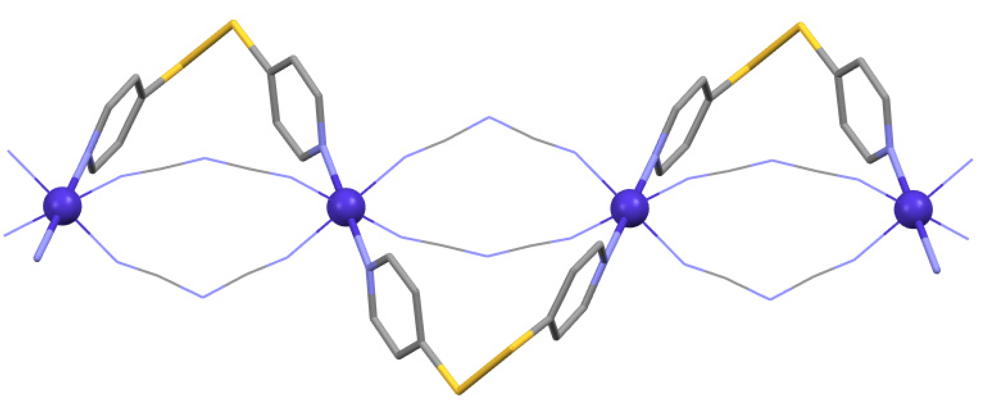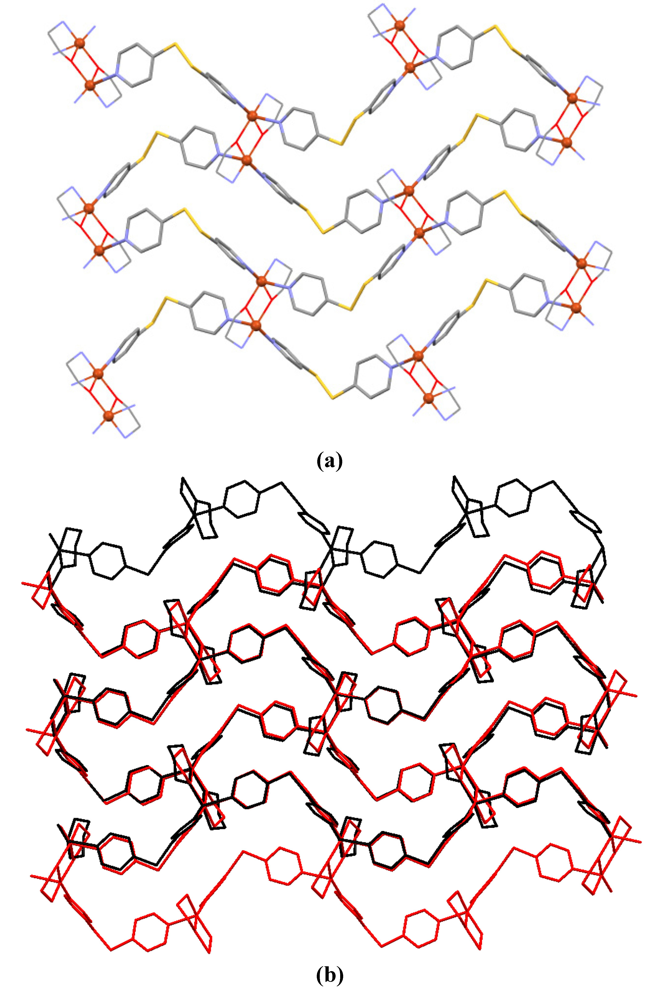The
dtdp containing metallosupramolecular compounds in this review have been classified according to the topologies of the structures in the solid-state. This approach seems to be more appropriate than a classification by the nature of the metal units or reaction conditions, such as the solvents used in the supramolecular synthesis [
37], since it is often the topologies that are of interest. When appropriate, cross-references are made.
Figure 3 depicts some basic structural motifs found in metallosupramolecular assemblies derived from
dtdp. For the sake of consistency, the labelling scheme has been adapted from the review by Horikoshi and Mochida [
24]. Before we go into details, some clarification of the terminology used seems to be in order. We are not aware of a strict definition of what comprises a discrete metallosupramolecular species and the borderline between molecular and supramolecular coordination chemistry is blurred. It seems to be generally accepted, however, that macrocycles, boxes, cages and other higher order structures constructed from metal units and bridging ligands are labelled metallosupramolecular. In this sense, macrocycles with M
2L
2 topology,
i.e., two metal units joined by two
dtdp ligands, are, as far as we can ascertain, the only discrete structurally characterised metallosupramolecular compounds that have been obtained with
dtdp so far. Provisional recommendations on coordination polymer terminology by the International Union of Pure and Applied Chemistry (IUPAC) are currently in preparation [
38]. Accordingly, a coordination polymer is a coordination compound continuously extending in one, two or three dimensions. Coordination networks have been defined as a subset of coordination polymers and represent either one-dimensional coordination polymers with cross-links between two or more individual chains, loops or spiro-links, or two- or three-dimensional coordination polymers. Following these definitions,
dtdp containing structures with repeated rhomboid, necklace and tubular chain, as well as the (4,4) net topology, may be labeled as coordination networks, whereas helical, arched and zigzag chains belong to the group of pure one-dimensional coordination polymers.
3.1. M2L2 Macrocycles
Metallamacrocycles composed of two
cis-configured square-planar or octahedral metal units joined by two
dtdp ligands (M
2L
2 topology) are achiral or chiral, depending on the conformation of the
dtdp ligands. The achiral macrocycles contain two
dtdp ligands of opposite handedness, resulting in a chair-like centrosymmetric structure, whereas the chiral ones exclusively contain two
dtdp ligands of either the
P or the
M form. To our knowledge, only racemic crystals of the latter have been reported so far.
Table 1 lists crystallographically characterised M
2L
2 macrocycles containing
dtdp as bridging ligands.
In general, we need to distinguish between the two main methods of formation of metallo-supramolecular species. The use of more inert
cis-preconfigured 4d or 5d metal precursors enables self-assembly in solution mainly under thermodynamic control, that is, chemical equilibrium is maintained at all time during the supramolecular reaction. Under appropriate conditions, e.g., solvents, concentration ranges, temperature, solution self-assembly of complementary, geometrically suitable building blocks can give anticipated macrocyclic structures in high yield. This has to be contrasted with non-equilibrium processes. It is generally accepted that crystallisation is mainly a kinetic-based process [
44]; the product that forms fastest crystallises first. Crystalline products obtained by the directional-bonding approach using more labile 3d metal precursors assemble at the solvent-crystal interface. In this case, crystallisation can be considered as the supramolecular reaction. It is to be expected, therefore, that kinetic control favours polymerisation rather than the formation of macrocycles. As we shall see, M
2L
2 macrocycles have nevertheless been obtained by crystal engineering with labile 3d metal precursors and
dtdp. In these cases, the assumption has to be made that packing in the solid-state favours the macrocyclic structure. Since crystal packing is crucially influenced by the nature of co-ligands, counter-ions and solvent molecules, the crystal engineering approach is clearly less straightforward than deliberate synthesis of metallamacrocycles using monodentate bridging ligands by the solution-based directional-bonding approach.
Stang and co-workers were the first to report an M
2L
2 macrocycle with dtdp as bridging ligands in 2001 [
45]. When equimolar amounts of
cis-[Pt(NO
3)
2(Et
3P)
2] and dtdp were allowed to react in methanol-
d4 at room temperature,
1H and
31P-NMR spectroscopy revealed the formation of a closed, symmetric product. The observation of only one set of resonance signals each for the pyridyl groups of
dtdp and the Et
3P co-ligands is consistent with an M
2L
2 macrocycle with molecular
C2h symmetry. Single-crystal X-ray analysis showed the achiral chair-like structure of the macrocycle (XIWNEW), containing a crystallographic centre of symmetry (
Figure 4). It is interesting to note that, owing to the inertness of Pt(II) complexes, the
cis-configuration is retained without a chelate co-ligand. Xiao
et al., reported an achiral M
2L
2 macrocycle with Pd(II) corners,
cis-protected by an
N-heterocyclic carbene,
viz. 1,1′-dimesityl-3,3′-methylenediimidazolin-2,2′-diylidene [
46]. The macrocycle exhibits crystallographic
Ci symmetry, but the molecule adopts approximate
C2h point group symmetry (UMUGAL). Achiral macrocycles have also been obtained with half-sandwich complexes,
viz. [RuCl(
p-cymene)]
+, as corner units [
31]. Both the dichloromethane solvate (GAKHUX) and the chloroform solvate (GAKJAF) of [{RuCl(
p-cymene)}
2(
μ-
dtdp)
2](CF
3SO
3)
2 crystallise with crystallographic inversion symmetry imposed. [RhCl(Cp*)]
+ and [IrCl(Cp*)]
+ (Cp*
− = pentamethylcyclopentadienyl) corner units have been used to this end as well, but the metallamacrocycles obtained have not been characterised by X-ray crystallography [
31].
Table 1.
Selected structural parameters for M2L2 macrocycles.
Table 1.
Selected structural parameters for M2L2 macrocycles.
| Compound | Molecular Symmetry a | C–S–S–C torsion angle (°) | M···M separation (Å) | (S–S)···(S–S) separation (Å) | Reference | CSD Refcode |
|---|
| [{Pt(Et3P)2}2(μ
-dtdp)2](NO3)4·4CH3OH | Ci | 91.7 | 10.96 | 8.70 | [45] | XIWNEW |
| [{Pd(C25H28N4)}2(μ-dtdp)2](CF3SO3)4b | C2h | 84.9 | 10.61 | 9.06 | [46] | UMUGAL |
| [{RuCl(p-cymene)}2(μ-dtdp)2](CF3SO3)2·2CH2Cl2 | Ci | 83.5 | 10.46 | 9.53 | [31] | GAKHUX |
| [{RuCl(p-cymene)}2(μ-dtdp)2](CF3SO3)2·4CHCl3 | Ci | 85.1 | 10.64 | 9.36 | [31] | GAKJAF |
| [{Ir(H)2(PPh3)}2(μ-dtdp)2](BF4)2·3CH2Cl2·H2O c | D2 | 87.4, 87.2 | 10.72 | 9.37 | [47] | RUZKIG |
| [{Co(hfacac)2}2(μ-dtdp)2]·4CHCl3d | D2 | 90.8, 89.2 | 10.84 | 9.18 | [48] | FEBBEU |
| [{Ni(hfacac)2}2(μ-dtdp)2]·4CHCl3d | D2 | 91.3, 89.5 | 10.80 | 9.13 | [48] | FEBBIY |
| [{Co(hfacac)2}2(μ-dtdp)2]·H2O d,e | C2 | 78.5 | 10.16 | 9.74 | [48] | FEBBOE |
| [{Ni(hfacac)2}2(μ-dtdp)2]·H2O d,e | C2 | 78.0 | 10.05 | 9.70 | [48] | FEBBUK |
| [{Cu(CF3SO3)2(phen)}2(μ-dtdp)2]·0.13H2O f | Ci | 88.3 | 10.66 | 8.98 | [28] | INIMOI |
| [{Zn(C7H7COO)2}2(μ-dtdp)2] g | Ci | 79.6 | 9.94 | 9.91 | [49] | TAWTIW |
Figure 4.
Molecular structure of the achiral M2L2 macrocycle in [{Pt(PEt3)2}2(μ-dtdp)2](NO3)4·4CH3OH (XIWNEW).
Figure 4.
Molecular structure of the achiral M2L2 macrocycle in [{Pt(PEt3)2}2(μ-dtdp)2](NO3)4·4CH3OH (XIWNEW).
[{Ir(H)
2(PPh
3)
2}
2(
μ-
dtdp)
2](BF
4)
2 (RUZKIG) represents a chiral macrocycle with approximate molecular
D2 symmetry in the crystal (
Figure 5) [
47]. RUZKIG was obtained by reaction of [Ir(H)
2(PPh
3)
2(acetone)
2] with
dtdp in dichloromethane. The Ir(III) ions show a distorted octahedral coordination sphere with the two bulky triphenylphosphine (PPh
3) co-ligands in axial positions. The hydrido co-ligands and
dtdp bridging ligands each bind to two
cis-sites in the equatorial plane. In RUZKIG, the configuration of the precursor is also retained despite the absence of chelate co-ligands, which can be explained by the inert nature of Ir(III) complexes.
Figure 5.
Molecular structure of the chiral M2L2 macrocycle in [{Ir(H)2(PPh3)2}2(μ-dtdp)2](BF4)2·3CH2Cl2·H2O (RUZKIG). Note that the macrocycle shown contains the left-handed M form of dtdp in the centrosymmetric crystal structure.
Figure 5.
Molecular structure of the chiral M2L2 macrocycle in [{Ir(H)2(PPh3)2}2(μ-dtdp)2](BF4)2·3CH2Cl2·H2O (RUZKIG). Note that the macrocycle shown contains the left-handed M form of dtdp in the centrosymmetric crystal structure.
XIWNEW, UMUGAL, GAKHUX, GAKJAF and RUZKIG have also been characterised by NMR spectroscopy, which provides evidence for the existence of the metallamacrocycles in solution. As revealed by the intramolecular M···M and (S–S)···(S–S) distances in the crystal (
Table 1), the dimensions of the cavities are clearly too small to accommodate guest molecules. Therefore, it comes as no surprise that molecular recognition features of these metallamacrocycles have not been reported, as far as we can ascertain. The precise shape of the macrocycle, as defined by the C–S–S–C torsion angles and the intramolecular M···M and (S–S)···(S–S) distances (
Table 1), is assumed to be affected mainly by the steric demand of the co-ligands at the metal ions and the nature of the counter-ions and solvent guest molecules, which reside above and below the cavity. In XIWNEW the C–S–S–C torsion angles are the closest to the ideal 90°, which may indicate that the macrocycle is the least strained as compared with UMUGAL, GAKHUX, GAKJAF and RUZKIG. Comparison of the intramolecular M···M and (S–S)···(S–S) distances reveals in turn a more rhomboidally shaped macrocycle in XIWNEW.
M
2L
2 macrocycles derived from
dtdp and labile 3d metal precursor complexes have been described so far for Co(II), Ni(II), Cu(II) and Zn(II) as metal corners. Horikoshi and co-workers investigated reactions of
dtdp with M(hfacac)
2 (M = Mn
2+, Co
2+, Ni
2+ and Cu
2+; hfacac
− = 1,1,1,5,5,5-hexafluoroacetylacetonate) complexes [
48,
50]. Whereas combination of Mn(hfacac)
2 and Cu(hfacac)
2 units with
dtdp resulted in zigzag and helical chain coordination polymers (see
Section 3.2), M
2L
2 macrocycles were obtained with Co(hfacac)
2 and Ni(hfacac)
2 corner units [
48]. Addition of a solution of [Co(hfacac)
2(H
2O)
2] in diethylether to a solution of an equimolar amount of
dtdp in chloroform yielded orange crystals of [{Co(hfacac)
2}
2(
μ-
dtdp)
2]·4CHCl
3 (FEBBEU). Blue-green crystals of the isostructural [{Ni(hfacac)
2}
2(
μ-
dtdp)
2]·4CHCl
3 (FEBBIY) were obtained in analogy by using [Ni(hfacac)
2(H
2O)
2] as precursor complex.
Figure 6a shows the molecular structure of FEBBEU in the crystal. Two
cis-configured Co(hfacac)
2 units are joined by two
dtdp ligands of the same handedness. Furthermore, the presence two chelate co-ligands at each
cis-M(hfacac)
2 corner unit imposes chirality: the left-handed
Λ form of the
cis-Co(hfacac)
2 and
cis-Ni(hfacac)
2 units are combined with the right-handed
P form of
dtdp and
vice versa in FEBBEU and FEBBIY, respectively. In the crystal, the chiral M
2L
2 macrocycles contain a crystallographic twofold rotation axis, running through the centres of the disulfide moieties. The macrocycles, however, exhibit two additional, approximate non-crystallographic
C2 axis perpendicular to the crystallographic rotation axis. The point group symmetry of the molecule thus resembles
D2.
Mixing a solution of [Co(hfacac)
2(H
2O)
2] and [Ni(hfacac)
2(H
2O)
2] in tetrachloromethane with a solution of
dtdp in diethylether and recrystallisation of the raw products from diethylether yielded orange and blue-green crystals, reportedly of the composition [{Co(hfacac)
2}
2(
μ-
dtdp)
2]·H
2O (FEBBOE) and [{Ni(hfacac)
2}
2(
μ-
dtdp)
2]·H
2O (FEBBUK), respectively. FEBBOE and FEBBUK are isostructural like FEBBEU and FEBBIY. Since the crystal structures of FEBBOE und FEBBUK respectively contain solvent accessible voids of
ca. 309 and 208 Å
3 per unit cell volume, the description of the structures as monohydrates must at least be questioned. In contrast to FEBBEU and FEBBIY, the M
2L
2 macrocycles in FEBBOE and FEBBUK comprise two
dtdp ligands of the same handedness (
i.e., either the
Por the
M form) and two
cis-M(hfacac)
2 units that are enantiomers (
i.e., the left-handed
Λ and the right-handed
∆ form). The molecules thus exhibit
C2 point group symmetry (
Figure 6b), which is also the site symmetry in the crystal. The crystallographic twofold rotation axis passes through the two metal atoms in the macrocycle. FEBBOE and FEBBUK may be regarded as supramolecular isomers of FEBBEU and FEBBIY, respectively. For FEBBOE and FEBBUK, the packing of the macrocycles in the crystals is also different from FEBBEU and FEBBIY: not solvent guest molecules but trifluoromethane moieties of adjacent molecules sit above and below the cavity of the macrocycle. It is reasonable to assume that the different stereochemistry of the macrocycles in the chloroform solvates and reported monohydrates is dictated by the crystal packing. Comparison of the structural parameters (
Table 1), especially the C–S–S–C torsion angles, indicates that the macrocyclic units in FEBBEO and FEBBUK are significantly more strained than those in FEBBEU and FEBBIY.
Figure 6.
(a) Molecular structure of the M2L2 macrocycle in FEBBEU, showing the P form of the dtdp ligands and the Λ configuration of both cis-Co(hfacac)2 corner units; (b) Molecular structure of the macrocycle in FEBBOE, also showing the P form of the dtdp ligands. In this complex, one cis-Co(hfacac)2 corner unit adopts the left-handed Λ and the other the right-handed ∆ configuration (see text).
Figure 6.
(a) Molecular structure of the M2L2 macrocycle in FEBBEU, showing the P form of the dtdp ligands and the Λ configuration of both cis-Co(hfacac)2 corner units; (b) Molecular structure of the macrocycle in FEBBOE, also showing the P form of the dtdp ligands. In this complex, one cis-Co(hfacac)2 corner unit adopts the left-handed Λ and the other the right-handed ∆ configuration (see text).
It has been reported that FEBBEU, FEBBIY, FEBBOE and FEBBUK are soluble in common organic solvents such as chloroform; the macrocyclic complexes are neutral and the hfacac
− co-ligands should enhance the solubility further. Since no solution study (e.g., by optical spectroscopy in the visible region) has been reported, it remains an open question as to whether the equilibrium is on the side of the products,
i.e., the macrocycles, and if so, under what conditions, especially concentration ranges. It has furthermore been mentioned that FEBBEU and FEBBIY easily lose the chloroform guest molecules, whereas FEBBOE and FEBBUK are more stable towards loss of solvent guest molecules. Thermogravimetry and powder X-ray diffraction performed on a sample of dried material of FEBBEU indicated that the macrocyclic structure is not retained after removal of the solvent guest molecules. From thermogravimetric analysis of FEBBOE, it has been concluded that the macrocyclic complex is sufficiently stable to sublime [
48].
When a pale blue solution of [Cu(CF
3SO
3)
2(phen)(H
2O)
2] (phen = 1,10-phenanthroline) in aqueous ethanol was layered onto a solution of
dtdp in dichloromethane, deep blue crystalline material of [{Cu(CF
3SO
3)
2(phen)}
2(
μ-
dtdp)
2] (INIMOI) formed spontaneously [
28]. The molecular structure in the crystal represents an M
2L
2 macrocycle, exhibiting a crystallographic inversion centre. Two
dtdp ligands of opposite handedness join two Cu(II) ions each via two
cis coordination sites in the equatorial plane of the Jahn-Teller distorted octahedral coordination environment. The remaining two
cis sites are blocked by the phen chelate co-ligands, and the trifluormethanesulfonate counter-ions are monodentate bound to the apical positions via oxygen atoms of the sulfonate moieties. In the crystal, the macrocycles stack in such a way that CF
3SO
3− moieties of adjacent molecules are located above and below the cavities. Despite its non-polymeric structure, INIMOI is insoluble in common organic solvents except dimethylsulfoxide. Upon addition of dimethylsulfoxide, a pale blue solution is obtained from INIMOI. Optical spectroscopy in the visible region provided evidence that the metallamacrocyle dissociates into its building blocks under these conditions.
In situ reaction of cadmium(II) perchlorate,
dtdp and phen as
cis-protecting co-ligand resulted in the arched chain coordination polymer [{Cd(H
2O)(
dtdp)(phen)}(
μ-
dtdp)(ClO
4)
2·2CH
3OH·1.5H
2O]
n (INIMEY, see
Section 3.3).
In situ reaction of
dtdp with Zn(NO
3)
2·6H
2O, 3-methylbenzoic acid (C
7H
7COOH) and sodium hydroxide in aqueous methanol afforded colourless crystals of [{Zn(C
7H
7COO)
2}
2(
μ-
dtdp)
2] (TAWTIW), which represents another M
2L
2 macrocycle with crystallographically imposed inversion symmetry [
49]. Zn(II) ions bearing two bidentate-bound carboxylate groups of 3-methylbenzoate build the corner units; the coordination sphere of Zn(II) is best described as a severely distorted octahedron. The 3-methylbenzoate ligands are
cis arranged, and owing to the site symmetry in the crystal, the macrocycle necessarily contains both the
Λ and
∆ configuration of the
cis-Zn(C
7H
7COO)
2 corners. TAWTIW contains no solvent guest molecules in the crystal and obviously exhibits an efficient packing of the metallamacrocycles in the crystal, which presumably causes a strained macrocyclic entity, as indicated by the structural parameters in
Table 1. It is worth noting that using unsubstituted benzoic acid (C
6H
5COOH) instead of the 3-methyl substituted derivative under similar reaction conditions resulted in the formation of [Zn(C
6H
5COO)
2(
μ-
dtdp)]
n (TAWTES) [
49], a coordination polymer with helical chain structure (see
Section 3.2). Thus, the presence of a methyl group in the periphery of the co-ligands crucially affects the overall structure of the crystalline product. This clearly indicates that the formation of the metallamacrocyle in TAWTIW is induced by packing effects in the solid-state.
3.2. Repeated Rhomboids
In
dtdp containing coordination polymers of the repeated rhomboid type, two
dtdp ligands join two
trans-configured octahedral metal nodes each via two
cis coordination sites in the equatorial plane. Repeated rhomboids thus can be viewed as polymeric strands of fused M
2L
2 macrocycles, as mentioned in the previous section. As for discrete M
2L
2 macrocycles, the macrocyclic units can be composed of either two
dtdp ligands of the same or of the opposite handedness. Likewise, only racemic crystal structures of chiral repeated rhomboids have been observed so far. The polymeric chains of repeated rhomboids are thus either chiral or achiral with chair-like macrocyclic units. The apical positions at the metal ions are occupied by solvent molecules and/or counter-ions. Repeated rhomboids have been reported for Mn(II), Fe(II), Co(II), Cu(II), Zn(II) and Cd(II) so far.
Table 2 lists structural parameters of repeated rhomboids, roughly sorted by increasing atomic number of the metal ions involved.
The first coordination polymer with repeated rhomboid structure derived from
dtdp was reported by Kitagawa and co-workers in 2000 [
51]. Slow diffusion of an aqueous solution of Cd(NO
3)
2·4H
2O and a solution of
dtdp in ethanol into one another resulted in colourless crystals of [{Cd(H
2O)
2(
μ-
dtdp)
2}(NO
3)
2·2C
2H
5OH·2H
2O]
n (WOQXUV). The analogous methanol solvate (SOMHOS) has also been described [
52]. Both structures represent the achiral type of repeated rhomboids with Cd(II) occupying crystallographic inversion centres. The aqua ligands are in axial positions of the octahedrally coordinated Cd(II) ions.
Figure 7a shows the representative structure of a coordination polymer strand in SOMHOS. As revealed by
Table 2, a wider variety of repeated rhomboids have been derived from Zn(II) and Cu(II). In 2005, Horikoshi and Mikuriya reported a systematic study of repeated rhomboids obtained from
dtdp and Zn(II) with various counter-ions and from different solvent systems [
53]. In the particular case of zinc(II) nitrate, a variety of structures have been obtained. The solvent-free compound [Zn(NO
3)
2(
μ-
dtdp)
2]
n (FARLUG) represents the chiral type of repeated rhomboids with monodentate nitrato ligands in both apical positions of Zn(II) (
Figure 7b). The four pyridyl groups in the equatorial plane adopt a propeller-like arrangement around the metal ion, whereas
trans-related pyridyl groups are virtually co-planar in achiral repeated rhomboids (
Figure 7a). In [{Zn(NO
3)(H
2O)(
μ-
dtdp)
2}NO
3·4H
2O]
n (FARMAN), one of the nitrato ligands in FARLUG is replaced by an aqua ligand. The nitrato ligand in FARMAN shows rotational disorder about the Zn–O bond at room temperature [
53], and a disorder-order-transition upon cooling to 110 K has been observed [
54]. In contrast to FARLUG and FARMAN, [{Zn(H
2O)
2(
μ-
dtdp)
2}(NO
3)
2·2CH
3OH·2H
2O]
n (FARLOA) [
53] and the corresponding ethanol solvate (PAQMUR) [
54] exhibit achiral repeated rhomboids with aqua ligands in apical positions of Zn(II), as in the above-mentioned analogous structures obtained from Cd(NO
3)
2·4H
2O, SOMHOS and WOQXUV. The methanol solvates,
i.e., FARLOA and SOMHOS are isostructural. The metal ions in PAQMUR occupy
pseudo inversion centres in the already centrosymmetric crystal structure (space group
P1), as opposed to FARLOA, SOMHOS and WOQXUV. [{Zn(H
2O)
2(
μ-
dtdp)
2}(ClO
4)
2·2
dtdp]
n (FARMIV) and [{Zn(dmso)
2(
μ-
dtdp)
2}(ClO
4)
2]
n (FARMER) were obtained by using zinc(II) perchlorate as metal source [
53]. In both, the repeated rhomboids are chiral and contain a twofold crystallographic rotation axis, running through the Zn(II) ions along each polymeric strand. FARMIV contains two crystallographically distinct
dtdp guest molecules of opposite chirality (C–S–S–C torsion angles: 90.3° and −85.9°), which act as acceptors of O–H···N and C–H···N hydrogen bonds. FARLIU and [Zn(
μ-SiF
6)(
μ-
dtdp)
2·3CH
3OH]
n (LEMMAS) represent two further examples of achiral repeated rhomboids with Zn(II) nodes occupying crystallographic inversion centres. BOKXIJ and RAFWAY (
Table 2) both exhibit chiral repeated rhomboids, containing crystallographic twofold rotation axes that run along the polymeric strands. BOKXIJ contains hydrogen fumarate as counter-ions, whereas RAFWAY contains the isomeric hydrogen maleate.
Table 2.
Selected structural parameters for repeated rhomboids.
Table 2.
Selected structural parameters for repeated rhomboids.
| Compound | Rhomboids | C–S–S–C torsion angle (°) | M···M separation (Å) | (S–S)···(S–S) separation (Å) | Reference | CSD Refcode |
|---|
| [Mn(N3)2(μ-dtdp)2·dtdp]n | achiral | 87.7, −92.9 | 11.12 | 9.28 | [55] | DEPVAW |
| [Mn(C6H5COO)2(μ-dtdp)2·C6H5COOH·H2O]na | chiral | 89.3 | 10.94 | 9.54 | [56] | GEBZAQ |
| [Mn(NCS)2(μ-dtdp)2·0.5dtdp·0.5H2O]n | achiral | 87.6, −87.2
87.1, −86.5 | 10.89
10.89 | 9.56
9.58 | [57] | – |
| [Fe(NCS)2(μ-dtdp)2·2H2O]n b | chiral | 91.2 | 10.97 | 9.25 | [58] | CEBMAY |
| [Fe(NCS)2(μ-dtdp)2·3H2O]n | chiral | 91.8, 91.4 | 10.93 | 9.23 | [57] | – |
| [CoCl2(μ-dtdp)2·2CH3OH]n | achiral | 80.9 | 10.21 | 9.59 | [58] | CEBMEC |
| [Co(NCO)2(μ-dtdp)2·1.5H2O]n | achiral | 82.5
79.1 | 10.55
10.30 | 9.69
9.82 | [59] | – |
| [Co(NCS)2(μ-dtdp)2·dmso]nc | chiral | 90.0 | 10.83 | 9.18 | [60] | NIMBIV |
| [Co(NCS)2(μ-dtdp)2·2H2O]n | chiral | 91.3 | 10.91 | 9.19 | [57] | – |
| [{Cu(NO3)(H2O)(μ-dtdp)2}NO3·3H2O]n | chiral | 89.7 | 10.53 | 9.15 | [61] | EMADIF |
| [Cu(μ-SO4)(μ-dtdp)2·2CH3OH·3H2O]n | chiral | 88.4 | 10.55 | 9.12 | [61] | EMADEB |
| [{Cu(μ-N3)(μ-dtdp)2}ClO4·5H2O]n | chiral | 92.2 | 10.84 | 8.89 | [62] | GANPER |
| [Cu(ClO4)2(μ-dtdp)2·3H2O]n | chiral | 91.7 | 10.70 | 8.89 | [63] | VILKUX |
| [{Cu(H2O)2(μ-dtdp)2}(C5H4NSO3)2·2H2O]nd | chiral | 89.0 | 10.70 | 9.04 | [64] | VUKGAK |
| [Cu(C5H4NSO3)2(μ-dtdp)2·2H2O]nd | chiral | 88.7 | 10.56 | 9.06 | [64] | VUKGEO |
| [{Cu(H2O)2(μ-dtdp)2}(C8H5O4)2·H2O]ne | chiral | 90.5, 89.1 | 10.73 | 8.96 | [65] | DUMBAP |
| [{Cu(H2O)2(μ-dtdp)2}(CF3SO3)2]n | chiral | 84.8, 82.6 | 10.36 | 9.33 | [66] | UJEXAJ |
| [{Cu(H2O)2(μ-dtdp)2}(C4H3O4)2·4H2O]nf | chiral | 92.2 | 10.77 | 8.87 | [67] | RAFVUR |
| [{Cu(H2O)2(μ-dtdp)2}(C5H4NSO3)2]ng | chiral | 89.3 | 10.72 | 8.97 | [67] | RAFVIF |
| [Zn(NO3)2(μ-dtdp)2]n | chiral | 87.3, 87.1 | 10.88 | 9.23 | [53] | FARLUG |
| [{Zn(NO3)(H2O)(μ-dtdp)2}NO3·4H2O]n | chiral | 88.9, 88.9 | 10.67 | 9.37 | [53,54] | FARMAN |
| [{Zn(H2O)2(μ-dtdp)2}(NO3)2·2CH3OH·2H2O]n | achiral | 91.1 | 10.89 | 9.19 | [53] | FARLOA |
| [{Zn(H2O)2(μ-dtdp)2}(NO3)2·2C2H5OH·2H2O]n | achiral | 93.8, −93.2 | 11.02 | 9.09 | [54] | PAQMUR |
| [{Zn(H2O)2(μ-dtdp)2}(ClO4)2·4dtdp]n | chiral | 90.2 | 10.86 | 9.25 | [53] | FARMIV |
| [{Zn(dmso)2(μ-dtdp)2}(ClO4)2]nc | chiral | 88.8 | 10.82 | 9.27 | [53] | FARMER |
| [Zn(NCS)2(μ-dtdp)2·2dmf]nh | achiral | 86.0 | 10.61 | 9.59 | [53] | FARLIU |
| [Zn(μ-SiF6)(μ-dtdp)2·3CH3OH]n | achiral | 85.4 | 10.62 | 9.47 | [68] | LEMMAS |
| [{Zn(H2O)2(μ-dtdp)2}(C4H3O4)2]nf | chiral | 92.5 | 11.09 | 8.83 | [69] | BOKXIJ |
| [Zn(C7H7COO)2(μ-dtdp)2·H2O]ni | chiral | 97.1, 93.4 | 11.19 | 8.80 | [70] | QUXMUS |
| [{Zn(H2O)2(μ-dtdp)2}(C4H3O4)2·5H2O]nj | chiral | 91.5 | 10.95 | 9.18 | [67] | RAFWAY |
| [{Zn(H2O)2(μ-dtdp)2}(C5H4NSO3)2·2H2O]ng | chiral | 89.3 | 10.80 | 9.19 | [67] | RAFVOL |
| [{Cd(H2O)2(μ-dtdp)2}(NO3)2·2CH3OH·2H2O]n | achiral | 88.8 | 11.01 | 9.48 | [52] | SOMHOS |
| [{Cd(H2O)2(μ-dtdp)2}(NO3)2·2C2H5OH·2H2O]n | achiral | 89.7 | 11.11 | 9.50 | [51] | WOQXUV |
For Cu(II), an almost equal number of repeated rhomboids as for Zn(II) have been reported (
Table 2). Interestingly, only chiral repeated rhomboids derived from Cu(II) have been described so far. The majority, that is EMADEB, GANPER, VILKUX, VUKGAK, VUKGEO, RAFVIF and RAFVUR contain twofold rotation axes running along the polymeric strands in the crystal. EMADIF contains crystallographic twofold rotation axes passing through the Cu(II) ions perpendicular to the direction of propagation of the repeated rhomboids, whereas each two crystallographically unique
dtdp ligands of the same chirality form the rhomboids in DUMBAP and [{Cu(H
2O)
2(
μ-
dtdp)
2}(CF
3SO
3)
2]
n (UJEXAJ) [
65,
66]. [{Cu(H
2O)
2(
μ-
dtdp)
2}(C
5H
4NSO
3)
2·2H
2O]
n (VUKGAK) contains pyridine-4-sulfonate (C
5H
4NSO
3−), resulting from partial
in situ oxidative cleavage of
dtdp, as counter-ions and [{Cu(H
2O)
2(
μ-
dtdp)
2}(C
5H
4NSO
3)
2]
n (VUKGEO) as ancillary ligands. Carballo
et al., reasoned that the cleavage of
dtdp, which occurred under ambient conditions in mixtures containing Cu(II) formate or acetate, was mediated by Cu(II) [
64]. It is worthy of note that in VUKGEO the pyridine-4-thiolate binds to the apical positions of Cu(II) via a sulfonate oxygen atom, which is considered a weaker ligand than the pyridyl group. This is characteristic of octahedral Cu(II) complexes and has been attributed to a more electrostatic interaction between Cu(II) and the axial ligands as a result of the Jahn-Teller effect, associated with the d
9 electronic configuration [
71]. Temperature-dependent measurements of the magnetic susceptibility of EMADIF and VILKUX revealed weak antiferromagnetic coupling of the Cu(II) ions [
61,
63], consistent with the
intrachain M···M separations (
Table 2). In EMADEB and GANPER, however, the strands of repeated rhomboids are further connected by the axial
μ-sulfato and
μ-azido ancillary ligands, respectively.
Interchain ferromagnetic interactions were observed for the
μ-sulfato-linked EMADEB [
61], whereas weak antiferromagnetic coupling through the
μ-azido bridges was reported for GANPER [
62].
Figure 7.
(a) Achiral repeated rhomboid strand in [{Cd(H2O)2(μ-dtdp)2}(NO3)2·2CH3OH·2H2O]n (SOMHOS); (b) Chiral repeated rhomboid strand in [Zn(NO3)2(μ-dtdp)2]n (FARLUG). Note that the polymer strand shown contains the right-handed P form of dtdp in the centrosymmetric crystal structure.
Figure 7.
(a) Achiral repeated rhomboid strand in [{Cd(H2O)2(μ-dtdp)2}(NO3)2·2CH3OH·2H2O]n (SOMHOS); (b) Chiral repeated rhomboid strand in [Zn(NO3)2(μ-dtdp)2]n (FARLUG). Note that the polymer strand shown contains the right-handed P form of dtdp in the centrosymmetric crystal structure.
Repeated rhomboids derived from transition metal ions other than Cu(II) are scarce. In 2005, Suen
et al. reported [Fe(NCS)
2(
μ-
dtdp)
2·2H
2O]
n (CEBMAY) and [CoCl
2(
μ-
dtdp)
2·2CH
3OH]
n (CEBMEC), exhibiting chiral and achiral rhomboids, respectively [
58]. CEBMEC is the sole example of repeated rhomboids containing halide ions, and interestingly the axial Co–Cl distances of 2.92 Å are considerably longer than those of 2.44 Å in
trans-[CoCl
2(pyridine)
4] (TPYRCO01) [
72] with a propeller-like arrangement of the four pyridine ligands. The Jahn-Teller distortion characteristic of a d
7 low-spin electronic configuration of Co(II) could provide a plausible explanation for the increased axial Co–Cl bond lengths in CEBMEC. Magnetic properties, however, were reported neither for CEBMEC nor for NIMBIV, the latter of which exhibits chiral rhomboids with isothiocyanato ancillary ligands at the apical positions of Co(II) [
60]. In 2012, Cortés and co-workers reported structures and properties of [Mn(NCS)
2(
μ-
dtdp)
2·0.5
dtdp·0.5H
2O]
n, [Fe(NCS)
2(
μ-
dtdp)
2·3H
2O]
n and [Co(NCS)
2(
μ-
dtdp)
2·2H
2O]
n [
57]. The coordination network in [Fe(NCS)
2(
μ-
dtdp)
2·3H
2O]
n is isostructural to that in CEBMAY. For [Fe(NCS)
2(
μ-
dtdp)
2·3H
2O]
n,
Cc space group symmetry with a
β angle of the monoclinic unit cell close to 90° [91.97(1)°] and twinning by a twofold rotation about the
c* direction was reported, whereas CEBMAY was described in the orthorhombic space group
Ccc2 [
58], which is a supergroup of
Cc. The remarkable similarity between the two structures raises questions about the role of the water molecules in the crystal packing. [Co(NCS)
2(
μ-
dtdp)
2·2H
2O]
nand CEBMAY are in contrast isomorphous. Temperature-dependent magnetic susceptibility measurements indicated slight antiferromagnetic coupling in [Fe(NCS)
2(
μ-
dtdp)
2·3H
2O]
n and [Co(NCS)
2(
μ-
dtdp)
2·2H
2O]
n. Very recently, again the group of Cortés reported on the structure and properties of [Co(NCO)
2(
μ-
dtdp)
2·1.5H
2O]
n[
59]. The compound features two crystallographically distinct strands of achiral repeated rhomboids, which cross in the crystal, one strand extending in the [100] and the other in the [010] direction of the triclinic unit cell. Temperature-dependent magnetic susceptibility measurements performed at different fields indicated a spin canting phenomenon.
Interestingly, two structures derived from Mn(II), namely [Mn(N
3)
2(
μ-
dtdp)
2·
dtdp]
n (DEPVAW) [
55] and [Mn(NCS)
2(
μ-
dtdp)
2·0.5
dtdp·0.5H
2O]
n [
57], are the only examples of repeated rhomboids that crystallise in a Sohncke space group (
P2
1),
i.e., a space group that contains no mirror planes, glide planes or inversion centres. In both structures, the rhomboids are, however, formed from two crystallographically distinct
dtdp ligands of opposite chirality and therefore the coordination polymers are labelled achiral in
Table 2. Although there are significant differences in the C–S–S–C torsion angles, the
P and
M forms of
dtdp are approximately related by
local inversion centres within the repeated rhomboids, which do not extend to the rest of the structure. The asymmetric unit of DEPVAW contains a guest
dtdp molecule in
M conformation (C–S–S–C torsion angle: −91.5°), but it should be noted that the crystal studied was a twin by inversion, as indicated by a Flack x parameter of 0.33(2) [
73], so both hands were present in the crystal studied. [Mn(NCS)
2(
μ-
dtdp)
2·0.5
dtdp·0.5H
2O]
n contains two crystallographically distinct achiral strands of repeated rhomboids. The asymmetric unit furthermore contains a disordered
dtdp guest molecule, which has been described with a split model comprising the
P and
M forms. According to the Flack x parameter of 0.02(2), the crystal studied was enantiopure, but it has not been reported whether the bulk sample was enantiopure or a conglomerate. Considering that the starting material was racemic, the latter seems more likely. [Mn(C
6H
5COO)
2(
μ-
dtdp)
2·C
6H
5COOH·H
2O]
n (GEBZAQ), a chiral repeated rhomboid coordination polymer from Mn(II) with benzoato ancillary ligands, was reported recently [
56]. From temperature-dependent magnetic susceptibility measurements of DEPVAW, [Mn(NCS)
2(
μ-
dtdp)
2·0.5
dtdp·0.5H
2O]
n and GEBZAQ, the authors of the studies concluded that the Mn(II) ions are in high-spin state with respectively very weak antiferromagnetic coupling [
55,
57] and no significant magnetic interaction [
56], as expected in view of the long intrachain M···M distances (
Table 2).
The listing in
Table 2 reveals that chiral repeated rhomboids represent the majority of the structures that have been reported so far. Nevertheless, no simple correlation between the conformational preference of
dtdp and the nature of the metal nodes, ancillary ligands, counter-ions and guest molecules is obvious. It is interesting to note that the cationic coordination polymer [Zn(H
2O)
2(
μ-
dtdp)
2]
nn2+ exhibits achiral rhomboids in FARLOA and PAQMUR but chiral ones in BOKXIJ. This phenomenon can be described as conformational supramolecular isomerism [
39]. In most cases, a compact arrangement of adjacent repeated rhomboid strands that are parallel in the crystal is achieved as shown
Figure 8a, resulting in corrugated layers (
Figure 8b). These are offset or face-to-face stacked in the third dimension (
Figure 9). Face-to-face stacking results in a pillared structure. As with discrete M
2L
2 macrocycles (see
Section 3.1), counter-ions, guest molecules or ancillary ligands of an adjacent strand reside above and below the cavities of the rhomboids. Guest molecules with hydrogen bonding donor capabilities, such as methanol, ethanol and water, are mostly involved in intricate hydrogen bonding networks in the crystal. The packing of the repeated rhomboid strands in DEPVAW and UJEXAJ resembles a herring-bone pattern. With a tetragonal crystal structure (space group
P4), the arrangement of the repeated rhomboid strands in FARMER is also remarkably different from the other examples. As aforementioned, in EMADEB and GANPER the strands that are face-to-face stacked are joined into two-dimensional coordination networks via the axial coordination sites of Cu(II) through
μ-sulfato and
μ-azido ancillary ligands, respectively. LEMMAS is a unique example of repeated rhomboids linked into a three-dimensional coordination network [
68]. In the crystal, the strands that are crossed, extending in the [110] and [1
10] directions, are connected through
μ-hexafluorosilicato ancillary ligands via the apical positions of Zn(II) in the [001] direction. It is intriguing that in all the crystal structures described in this section, the metal atoms in the individual repeated rhomboid strands ···M···M···M···M··· are despite different crystal environments colinear, although they need not be.
Figure 8.
(a) Compact arrangement of two adjacent repeated rhomboid strands and (b) corrugated layers viewed along the direction of propagation of the strands in [{Cd(H2O)2(μ-dtdp)2}(NO3)2·2CH3OH·2H2O]n (SOMHOS) with nitrate ions and solvent molecules sandwiched in between.
Figure 8.
(a) Compact arrangement of two adjacent repeated rhomboid strands and (b) corrugated layers viewed along the direction of propagation of the strands in [{Cd(H2O)2(μ-dtdp)2}(NO3)2·2CH3OH·2H2O]n (SOMHOS) with nitrate ions and solvent molecules sandwiched in between.
Figure 9.
(a) Off-set stacking of two adjacent strands in [Zn(NO3)2(μ-dtdp)2]n (FARLUG) and (b) face-to-face stacking in [{Cu(H2O)2(μ-dtdp)2}(C4H3O4)2·4H2O]n (RAVFUR).
Figure 9.
(a) Off-set stacking of two adjacent strands in [Zn(NO3)2(μ-dtdp)2]n (FARLUG) and (b) face-to-face stacking in [{Cu(H2O)2(μ-dtdp)2}(C4H3O4)2·4H2O]n (RAVFUR).
3.3. Arched Chains
Table 3 lists coordination polymers of the arched chain type derived from
dtdp. These consist of angular metal fragments linked by just one
dtdp moiety to form open polymeric chains. The metal nodes are mostly provided by tetrahedrally or
cis-configured octahedrally coordinated metal ions. The structures in
Table 3 are sorted by increasing atomic number of the metal ions serving as nodes. In all structures, the arched chains exclusively contain one enantiomer of
dtdp, although neighbouring chains contain perforce the other enantiomer, since the crystal structures are without exception centrosymmetric and thus racemic. [Cd(C
6H
14O
2PS
2)
2(
μ-
dtdp)]
n (BILFAE), the first example of an arched chain with
dtdp bridges, was reported by Lai and Tiekink in 2004 [
74]. The corresponding Zn(II) derivative exhibits a distorted zigzag chain structure (see
Section 3.4 and
Figure 3).
Figure 10a depicts an arched chain strand in BILFAE, composed of
cis-[Cd(C
6H
14O
2PS
2)
2] (C
6H
14O
2S
2− =
O,
O′-diisopropyldithiophosphate) fragments joined by
dtdp via the two remaining
cis sites of Cd(II). The configuration of the
cis-[Cd(C
6H
14O
2PS
2)
2] units and the conformation of
dtdp exhibit the same handedness in one arched chain. Thus, in one polymer strand the
P form of
dtdp links
cis metal units in
∆ configuration, whereas in symmetry-related strands the
M form of
dtdp joins
cis metal units in
Λ configuration. The C–S–S–C torsion angle in BILFAE at 74.3° is remarkably smaller than the ideal 90°. The same holds for N
pyridine–Cd–N
pyridine bond angle of 81.2°. The intrachain M···M distance is the shortest observed in arched chains. Additionally, there is a calculated void of 16.84 Å
3 at the origin of the unit cell. These structural parameters indicate that the arched chains in BILFAE are the most compressed in the direction of propagation in the crystal of the arched chain structures listed in
Table 3. This contrasts strongly with [Co(H
2O)
2(C
5O
5)(
μ-
dtdp)·1.5H
2O]
n (C
5O
52− = croconate) (TEZQUL) [
75], in which torsion angles of 91.7° and 101.7° are observed. It is interesting to note that the asymmetric units of TEZQUL and [{Cd(H
2O)(
dtdp)(phen)}(
μ-
dtdp)(ClO
4)
2·2CH
3OH·1.5H
2O]
n (INIMEY) [
28] in the crystal each contain two chemically similar but crystallographically distinct ML repeat units of the coordination polymers, which can be interpreted in terms of
Z′ = 2 [
76,
77], and these independent units are alternately incorporated in the respective chains with the same chirality. The polymer strands are interlaced in TEZQUL and parallel to one another in INIMEY. As shown in
Table 3, the C–S–S–C torsion angles corresponding to the
μ-
dtdp ligands are virtually equal in INIMEY but differ greatly in TEZQUL. In contrast to BILFAE, the right-handed
P form of
dtdp and
cis-[Co(H
2O)
2(C
5O
5)] exhibiting the left-handed
Λ configuration in TEZQUL form an arched chain and
vice versa (
Figure 10b).
Table 3.
Selected structural parameters for arched chains.
Table 3.
Selected structural parameters for arched chains.
| Compound | C–S–S–C torsion angle (°) | M···M separation (Å) | Reference | CSD Refcode |
|---|
| [Co(H2O)2(C5O5)(μ-dtdp)·1.5H2O]n a | 91.7, 101.7 | 11.00, 12.40 | [75] | TEZQUL |
| [Cu(C2H3O3)2(μ-dtdp)·4H2O]n b | 82.9 | 10.17 | [26] | UFAVED |
| [Cu(C3H5O3)2(μ-dtdp)·4H2O]n c | 88.9 | 10.51 | [78] | TOKDUT |
| [{Cu(NO3)(H2O)(en)(μ-dtdp)}NO3·4H2O]n d | 98.4 | 11.09 | [79] | FOTVEQ |
| [Zn(CH3COO)2(μ-dtdp)]n | 89.6 | 10.94 | [80,81] | FAYQUS |
| [Zn(NCS)2(μ-dtdp)]n | 91.5 | 11.05 | [58,81] | CEBLUR |
| [ZnCl2(μ-dtdp)]n | 91.8 | 10.95 | [82] | YEJDAU |
| [ZnBr2(μ-dtdp)]n | 89.9 | 10.84 | [83] | – |
| [Zn(C6H5COO)2(μ-dtdp)]n e | 93.9 | 11.15 | [49] | TAWTES |
| [Cd(C6H14O2PS2)2(μ-dtdp)]n f | 74.3 | 9.88 | [74] | BILFAE |
| [{Cd(H2O)(dtdp)(phen)}(μ-dtdp)(ClO4)2·2CH3OH·1.5H2O]n | 86.2, 86.0
85.3 g, 90.7 g | 10.70, 10.84 | [28] | INIMEY |
Figure 10.
(a) Arched chain in [Cd(C6H14O2S2)2(μ-dtdp)]n (BILFAE), showing the right-handed P form of dtdp and the right-handed ∆ configuration of the cis-octahedral metal units; (b) Arched chain in [Co(H2O)2(C5O5)(μ-dtdp)·1.5H2O]n (TEZQUL), showingthe P form of the crystallographically distinct dtdp ligands and the left-handed Λ configuration of the metal units.
Figure 10.
(a) Arched chain in [Cd(C6H14O2S2)2(μ-dtdp)]n (BILFAE), showing the right-handed P form of dtdp and the right-handed ∆ configuration of the cis-octahedral metal units; (b) Arched chain in [Co(H2O)2(C5O5)(μ-dtdp)·1.5H2O]n (TEZQUL), showingthe P form of the crystallographically distinct dtdp ligands and the left-handed Λ configuration of the metal units.
As far as we are able to ascertain, INIMEY is the sole example of a structure in which
μ-bridging and terminal
dtdp ligands coexist (
Figure 11), whereas 4,4′-bipyridine has been frequently observed coexisting as
μ-bridging and terminal ligands in coordination polymers [
84,
85]. The scarcity of similar structures derived from
dtdp has been addressed in the introduction. Interestingly, the two terminal
dtdp ligands in the asymmetric unit of INIMEY are of the same handedness (C–S–S–C torsion angles: 90.7° and 85.3°) as the two
μ-bridging ones. The non-coordinating pyridyl groups act as acceptors for O–H···N hydrogen bonds. The phen co-ligands at the metal were purposefully introduced as
cis-protecting groups, and it is worth pointing out that a polymeric arched chain resulted from self-assembly with
dtdp rather than an M
2L
2 macrocycle like in INIMOI, which was obtained from [Cu(CF
3SO
3)(phen)(H
2O)
2] as
cis-preconfigured metal precursor (see
Section 3.1).
Figure 11.
Arched chain in [{Cd(H2O)(dtdp)(phen)}(μ-dtdp)(ClO4)2·2CH3OH·1.5H2O]n (INIMEY), showing both crystallographically distinct μ-dtdp ligands (all dtdp ligands shown exhibit the P conformation).
Figure 11.
Arched chain in [{Cd(H2O)(dtdp)(phen)}(μ-dtdp)(ClO4)2·2CH3OH·1.5H2O]n (INIMEY), showing both crystallographically distinct μ-dtdp ligands (all dtdp ligands shown exhibit the P conformation).
In situ reaction of Cu(NO
3)
2·3H
2O, ethylenediamine (en) and
dtdp yielded dark blue crystals of [{Cu(NO
3)(H
2O)(en)(
μ-
dtdp)}NO
3·4H
2O]
n (FOTVEQ) [
79]. As anticipated, the en chelate ligand acts as
cis-protecting co-ligand in the equatorial plane of the coordination sphere of Cu(II). The
cis metal units so formed are joined by
dtdp via the two remaining equatorial
cis coordination sites to form an arched chain (
Figure 12). The octahedral coordination sphere of Cu(II) is completed by an aqua and a nitrato ligand in the two apical positions. Owing to the twisted conformation, five-membered chelate rings formed from en are chiral. In FOTVEQ, the right-handed
P form of
dtdp forms a polymer strand with the left-handed
λ form of the Cu(en)
2+ entities and
vice versa.
Figure 12.
Arched chain in [{Cu(NO3)(H2O)(en)(μ-dtdp)}NO3·4H2O]n (FOTVEQ), showing the right-handed P form of dtdp and the left-handed λ form of the Cu(en)2+ units.
Figure 12.
Arched chain in [{Cu(NO3)(H2O)(en)(μ-dtdp)}NO3·4H2O]n (FOTVEQ), showing the right-handed P form of dtdp and the left-handed λ form of the Cu(en)2+ units.
Carballo
et al. reported two arched chains that are essentially similar to BILFAE. In [Cu(glycolate)
2(
μ-
dtdp)·4H
2O]
n (UFAVED) [
26] and [Cu(lactate)
2(
μ-
dtdp)·4H
2O]
n (TOKDUT) [
78], the
dtdp linkages and the
cis-Cu(glycolate)
2 and
cis-Cu(lactate)
2 units, respectively, exhibit the same chirality in each polymer strand. Interestingly, the configuration of the lactato co-ligands in TOKDUT is also of the same handedness (
Figure 13). In UFAVED, twofold crystallographic rotation axes run through the centre of the disulfide moiety and the metal corner unit perpendicular to the direction of propagation of the polymer strands.
Figure 13.
Arched chain in [Cu(lactate)2(μ-dtdp)·4H2O]n (TOKDUT), showing the P form of dtdp and ∆-configured cis-Cu(R-lactate)2 units.
Figure 13.
Arched chain in [Cu(lactate)2(μ-dtdp)·4H2O]n (TOKDUT), showing the P form of dtdp and ∆-configured cis-Cu(R-lactate)2 units.
[Zn(CH
3COO)
2(
μ-
dtdp)]
n (FAYQUS) [
80,
81], [Zn(NCS)
2(
μ-
dtdp)]
n (CEBLUR) [
58,
81], [ZnCl
2(
μ-
dtdp)]
n (YEJDAU) [
82] and [ZnBr
2(
μ-
dtdp)]
n [
83] form an isomorphous series of arched chains, in which tetrahedrally coordinated Zn(II) ions are joined by
dtdp. In each case, two monodentate-bound acetato (FAYQUS01), isothiocyanato (CEBLUR01) and chlorido (CEBLUR01) ancillary ligands complete the coordination sphere of Zn(II). In the crystal, arched chains formed from
μ-
dtdp ligands of opposite chirality are tightly packed, as shown for CEBLUR01 in
Figure 14. All three structures crystallise with
C2/
c space group symmetry with the twofold crystallographic rotation axes in the [010] direction passing through the centre of the disulfide moieties of
dtdp and the Zn(II) ions. In YEJDAU, the chlorido derivative, the
β angle of the monoclinic unit cell is close to 90° with a value of 92.37(2)° and the crystal studied was a non-merohedral twin. The twin operation is a twofold rotation about the [001] direction, which coincides with the direction of propagation of the polymer strands in the crystal. The same sort of twinning was found in the bromido analogue, [ZnBr
2(
μ-
dtdp)]
n [
β = 91.21(3)°]. In [Zn(C
6H
5COO)
2(
μ-
dtdp)]
n (TAWTES), the arrangement of the arched chains with benzoato ancillary ligands in the coordination sphere of Zn(II) is essentially comparable [
49]. The Zn–O
carboxylate distances for the two benzoato ligands are 1.95/2.54 and 1.95/2.96 Å. Thus, the coordination modes may be regarded as asymmetric bidentate and monodentate, respectively. Accordingly, the coordination environment of Zn(II) can be described as a severely distorted trigonal-bipyramid. As mentioned in
Section 3.1, introducing 3-methylbenzoato co-ligands under similar conditions yielded an M
2L
2 macrocycle (TAWTIW), which reveals a structure-determining influence of the methyl group in the periphery of the benzoato co-ligands.
Figure 14.
Compact arrangement of two adjacent arched chains in [Zn(NCS)2(μ-dtdp)]n (CEBLUR01), containing μ-dtdp ligands of opposite chirality.
Figure 14.
Compact arrangement of two adjacent arched chains in [Zn(NCS)2(μ-dtdp)]n (CEBLUR01), containing μ-dtdp ligands of opposite chirality.
3.4. Zigzag and Helical Chains
Table 4 lists coordination polymers with zigzag and helical chain structure derived from
dtdp. Since the border between these two basic structural motifs can become rather blurred, the related structures are discussed in one section. [
trans-Mn(hfacac)
2(
μ-
dtdp)] (XEYTIE), the first example of a genuine zigzag chain structure containing
dtdp, was reported by Horikoshi
et al. in 2001 [
50]. In XEYTIE,
trans-configured Mn(hfacac)
2 units are joined by
dtdp ligands of opposite chirality in an alternating fashion (
Figure 15a). At around the same time, a structure comprising genuine helical chains with the composition [Cu(hfacac)
2(
μ-
dtdp)]
n (XEYTEA) was reported [
45,
50]. The helical chains in XEYTEA consist of
cis-configured Cu(hfacac)
2 units joined by
dtdp linkages of the same chirality (
Figure 15b). The helices so formed propagate by 2
1 screw symmetry in the crystal and exhibit a handedness opposite to the chirality of the
cis-Cu(hfacac)
2 and
dtdp building blocks. XEYTIE and XEYTEA were obtained under similar conditions, that is, from a mixture of
dtdp and the M(hfacac)
2·2H
2O (M = Cu, Mn) precursor in methanol. The helical supramolecular isomer of XEYTIE, [
cis-Mn(hfacac)
2(
μ-
dtdp)]
n (XEYTIE01), which is isotructural with XEYTEA (M = Cu), crystallised from a solution of [Mn(hfacac)
2(H
2O)] and
dtdp in a mixture of tetrachloromethane and dietheylether. Owing to the lability towards ligand substitution, M(hfacac)
2 precursors with 3d metal ions can undergo
cis-
trans isomerisation during the crystallisation. Reaction of Cu(hfacac)
2·2H
2O and
dtdp, however, led to the helical chain structure, regardless of the solvent system studied [
86]. XEYTIE and XEYTIE01 represent a remarkable example of supramolecular isomerism induced by the solvent system, all the more notable because solvent guest molecules were not encountered in the final outcome of crystallisation. As reported in
Section 3.1, M
2L
2 macrocycles were obtained from [Co(hfacac)
2(H
2O)
2] and [Ni(hfacac)
2(H
2O)] and
dtdp, independent of the solvent system used.
Table 4.
Selected structural parameters for zigzag and helical chains.
Table 4.
Selected structural parameters for zigzag and helical chains.
| Compound | C–S–S–C torsion angle (°) | M···M separation (Å) | Reference | CSD Refcode |
|---|
| [trans-Mn(hfacac)2(μ-dtdp)]n a | 90.9 | 11.79 | [50] | XEYTIE |
| [cis-Mn(hfacac)2(μ-dtdp)]n a | 90.1 | 11.47 | [48] | XEYTIE01 |
| [Cu(hfacac)2(μ-dtdp)]n a | 91.9 | 11.26 | [45,50] | XEYTEA |
| [Ni(C8H10O2PS2)2(μ-dtdp)]n b | 71.4 | 9.73 | [87] | NIPVUE |
| [Cu(CH3COO)2(μ-dtdp)·6H2O]n | not available | [86] | PAWCAS |
| [Zn(C6H14O2PS2)2(μ-dtdp)]n c | 90.2 | 11.04 | [88] | VEDDAK |
| [{Ag(μ-dtdp)}NO3·0.5CH3CN]n | 83.2 | 10.15 | [89] | EDOHEK |
| [{Ag(μ-dtdp)}C7H7SO3]n d | 96.2 | 10.44 | [89] | EDOHAG |
The coordination polymer strands in [Ni(C
8H
10O
2PS
2)
2(
μ-
dtdp)]
n (NIPVUE) (C
8H
10O
2PS
2 =
O-methyl(4-methoxyphenyl)phosphonodithioate) [
87] can be regarded as an intermediate between zigzag and helical chain (
Figure 16). Each single strand in the centrosymmetric crystal structure is composed of
dtdp ligands of the same chirality and
trans-configured Ni(C
8H
10O
2PS
2)
2 units as linear connectors. The chains thus formed extend by 2
1 screw symmetry in the crystal. The C–S–S–C torsion angle deviates remarkably from the ideal 90°, indicating that there is some strain in the structure. In contrast to XEYTEA and XEYTIE01, the helicity of the strands in NIPVUE exhibits the same handedness as the
dtdp ligands they are built from.
Figure 15.
(a) Achiral zigzag chain structure in [trans-Mn(hfacac)2(μ-dtdp)] (XEYTIE); (b) Helical chain structure in [Cu(hfacac)2(μ-dtdp)]n (XEYTEA), showing the P form of dtdp and the ∆ configuration of the cis-Cu(hfacac)2 units. The helix so formed is, however, left-handed.
Figure 15.
(a) Achiral zigzag chain structure in [trans-Mn(hfacac)2(μ-dtdp)] (XEYTIE); (b) Helical chain structure in [Cu(hfacac)2(μ-dtdp)]n (XEYTEA), showing the P form of dtdp and the ∆ configuration of the cis-Cu(hfacac)2 units. The helix so formed is, however, left-handed.
Figure 16.
Coordination polymer strand in [Ni(C8H10O2PS2)2(μ-dtdp)]n (NIPVUE), showing the P form of dtdp.
Figure 16.
Coordination polymer strand in [Ni(C8H10O2PS2)2(μ-dtdp)]n (NIPVUE), showing the P form of dtdp.
[Cu(CH
3COO)
2(
μ-
dtdp)·6H
2O]
n (PAWCAS) represents a zigzag chain similar to XEYTIE, where
dtdp ligands of opposite handedness are connected by
trans-Cu(CH
3COO)
2 units, serving as linear connectors. The structure has been described by Horiksohi and Mikuryia, but three-dimensional coordinates of the crystal structure have not been published [
86]. As reported in
Section 3.3, an analogous Zn(II) coordination polymer (FAYQUS) exhibits the arched chain structure, in which the Zn(II) ions are in a tetrahedral coordination environment with monodentate-bound acetato ancillary ligands. Coordination polymers of
dtdp with multinuclear nodes derived from copper(II) acetate are described in
Section 3.6.
[Zn(C
6H
14O
2PS
2)
2(
μ-
dtdp)]
n (VEDDAK) (C
6H
14O
2PS
2− = isopropyldithiophosphonate) can be seen as a distorted version of a zigzag chain (
Figure 17) [
88]. The chains in VEDDAK are composed of
dtdp building blocks of opposite chirality in an alternating fashion joined by tetrahedrally coordinated Zn(II) ions with two monodentate bound isopropyldithiophosphonato ancillary ligands. As described in
Section 3.3, an arched chain (BILFAE) is formed from
dtdp and the heavier group homologue Cd(II) with the same co-ligands but there acting as bidentate chelate ligands.
Figure 17.
Distorted zigzag chain in [Zn(C6H14O2S2)2(μ-dtdp)]n (VEDDAK), showing an M–LP–M–LM–M–LP–M–LM–M sequence.
Figure 17.
Distorted zigzag chain in [Zn(C6H14O2S2)2(μ-dtdp)]n (VEDDAK), showing an M–LP–M–LM–M–LP–M–LM–M sequence.
In 2002, Horikoshi
et al. described the preparation and structural characterisation of a series of coordination polymers from
dtdp and silver(I) salts [
89]. An intermediate zigzag/helical chain was obtained from AgNO
3 and a zigzag chain structure with Ag–Ag cross-links was isolated in the presence of 4-toluenesulfonate counter-ions, whereas silver(I) hexafluorophosphate and perchlorate afforded two-dimensional coordination networks with (4,4) net topology (see
Section 3.5). In [{Ag(
μ-
dtdp)}NO
3·0.5CH
3CN]
n (EDOHEK), Ag(I) ions adopt a characteristic two-coordination, connecting two
dtdp building blocks in an almost linear fashion (
Figure 18a). All
dtdp ligands in a single strand are of the same chirality. In the crystal, the chains thus formed extend by 2
1 screw symmetry. Similar to NIPVUE, the coordination polymer strands in EDOHEK are best described as intermediate between zigzag and helical chains. Likewise, the helicity of the entire strands is the same as that of the
dtdp building blocks. The strands of the same handedness are tightly packed to form layers. Layers of opposite handedness stack in an alternating fashion, with nitrate ions linking the coordination polymer at Ag(I) (
Figure 18b). Acetonitrile guest molecules fill the voids. In [{Ag(
μ-
dtdp)}C
7H
7SO
3]
n(EDOHAG), alternating
dtdp building blocks of opposite chirality are connected by Ag(I) ions in a nearly linear fashion to form zigzag chains, which are cross-linked by
interchain Ag–Ag bonds (Ag–Ag distance: 3.05 Å). The Ag(I) ions adopt a T-shaped coordination geometry (
Figure 18c). EDOHAG thus in fact represents a two-dimensional coordination network. In the crystal, the sheets so formed stack with layers of 4-toluenesulfonate in between.
Figure 18.
(a) Compact arrangement of two adjacent strands in [{Ag(μ-dtdp)}NO3·0.5CH3CN]n (EDOHEK), showing the P form dtdp; (b) Opposite-handed strands of EDOHEK linked by nitrate ions at Ag(I); (c) Adjacent zigzag chainsin [{Ag(μ-dtdp)}C7H7SO3]n (EDOHAG) with Ag–Ag (d10–d10) cross-links, showing M–LP–M–LM–M–LP–M sequences in the chains.
Figure 18.
(a) Compact arrangement of two adjacent strands in [{Ag(μ-dtdp)}NO3·0.5CH3CN]n (EDOHEK), showing the P form dtdp; (b) Opposite-handed strands of EDOHEK linked by nitrate ions at Ag(I); (c) Adjacent zigzag chainsin [{Ag(μ-dtdp)}C7H7SO3]n (EDOHAG) with Ag–Ag (d10–d10) cross-links, showing M–LP–M–LM–M–LP–M sequences in the chains.
3.6. Coordination Polymers Based on Metal Carboxylate Clusters
This section describes coordination polymers containing the
dtdp ligand and metal carboxylate clusters as nodes.
Table 5 lists relevant structures, roughly sorted by complexity and increasing atomic number of the metal ions involved. [Co
3(
μ3-OH)(tbip)
2(Htbip)(
μ-C
10H
8N
2S)(
μ-
dtdp)
0.5]
n (GUXPIZ, tbip
2− = 5-
tert-butylisophthalate, C
10H
8N
2S = 4,4′-dipyridylsulfide) was obtained by the reaction of Co(CH
3COO)
2·4H
2O with H
2tbip in a methanol/acetonitrile mixture [
90]. The 4,4′-dipyridylsulfide bridging ligand encountered in the structure results from partial
in situ S–S and C–S cleavage and rearrangement reactions of
dtdp. GUXPIZ represents a three-dimensional coordination network.
Figure 21 depicts a characteristic unit of the structure. The nodes are formed by trinuclear
μ3-hydroxido-bridged Co(II) clusters. Four bidentate
μ-carboxylate groups, a monodentate-bound carboxylate group, a monodenate-bound neutral carboxyl group as well as three pyridyl groups are attached to the cluster. The crystal structure of GUXPIZ is chiral with orthorhombic
P2
12
12 space group symmetry. It has not been reported whether the bulk sample was enantiopure or whether the compound crystallised as a conglomerate, although this is more likely in the absence of an external source of chirality. As shown in
Figure 21, two nodes are triply joined by two Htbip
− ligands and a
dtdp ligand exhibiting the right-handed
P conformation. The C–S–S–C torsion angle of
dtdp is remarkably small (
Table 5), which can be attributed to the fact that the M···M distance is dictated by the Htbip
− ligands. A crystallographic twofold rotation axis parallel to the [001] direction runs through the centre of the disulfide moiety. In this direction, the trinuclear Co(II) nodes are doubly bridged by an
in situ formed 4,4′-dipyridylsulfide and a tbip
2− ligand. Another tbip
2− ligand links a node to an ajdacent node in the [100] direction. Thus, each trinuclear Co(II) cluster can be viewed as a five-connecting node. The overall topolgy of the resulting three-dimensional coordination network has been described as a boron nitride (
bnn) type [
91]. Magnetic susceptibility measurements revealed ferromagnetic coupling within the trinuclear Co(II) nodes.
Table 5.
Selected structural parameters for coordination polymers based on metal carboxylate clusters.
Table 5.
Selected structural parameters for coordination polymers based on metal carboxylate clusters.
| Compound | C–S–S–C torsion angle (°) | M···M separation (Å) a | Reference | CSD Refcode |
|---|
| [Co3(μ3-OH)(tbip)2(Htbip)(μ-C10H8N2S)(μ-dtdp)0.5]n b | 72.5 | 7.94 | [90] | GUXPIZ |
| [Cu2(CH3COO)4(μ-dtdp)]n c | 89.6 | 11.39 | [92] | LIGPOH |
| [Cu2(C6H5COO)4(μ-dtdp)]n d | 86.5 | 10.62 | [86] | PAWBOF |
| [Cu2(C5H11COO)4(μ-dtdp)]n e | 90.6, −91.8 | 11.34, 11.42 | [86] | PAWBUL |
| [Cu4(CH3COO)6(μ3-OH)2(μ-dtdp)2]n | 81.3, 83.2 | 9.79, 9.90 | [86] | PAWBIZ |
| [Cu4(HCOO)6(μ3-OH)2(μ-dtdp)2·CH2Cl2]n | 75.3 | 9.40 | [64] | VUKFUD |
| [{Cu2(μ-C2O4)(H2O)4(μ-dtdp)2}(ClO4)2]n | 79.5 | 9.94 | [93] | RIRSOB |
| [Cu(malate)(μ-dtdp)·6H2O]n | 90.3 | 10.68 | [94] | MEFMEQ |
| [Zn7(CH3COO)10(μ4-O)2(μ-dtdp)]n | 85.5 | 10.43 | [95] | VAKZIR |
Figure 21.
Section of the crystal structure of [Co
3(
μ3-OH)(tbip)(Htbip)(
μ-C
10H
8N
2S)(
μ-
dtdp)
0.5]
n (GUXPIZ), viewed approximately along the [
100] direction. A crystallographic twofold rotation axis parallel to [001] bisects the
dtdp moiety.
Figure 21.
Section of the crystal structure of [Co
3(
μ3-OH)(tbip)(Htbip)(
μ-C
10H
8N
2S)(
μ-
dtdp)
0.5]
n (GUXPIZ), viewed approximately along the [
100] direction. A crystallographic twofold rotation axis parallel to [001] bisects the
dtdp moiety.
Three one-dimensional coordination polymers based on
dtdp and the well-known metal carboxylate paddle-wheel synthon [
96] have been reported. [Cu
2(CH
3COO)
4(
μ-
dtdp)]
n (LIGPOH) was obtained from Cu(CH
3COO)
2·H
2O and
dtdp in methanol [
92]. The structure features zigzag chains assembled from dinuclear copper(II) actetate paddle-wheel units as linear connectors joined by
dtdp ligands in the
P and
M conformation in an alternating fashion (
Figure 22). The one-dimensional coordination polymer strands are thus topologically similar to the zigzag chain with mononuclear, linear
trans-Mn(hfacac)
2 nodes (XEYTIE), described in
Section 3.4. The crystal structure of LIGPOH exhibits orthorhombic symmetry (space group
Pccn). The paddle-wheel unit contains a crystallographic centre of symmetry and the
dtdp ligand a twofold rotation axis passing through the centre of the disulfide moiety. In the crystal, adjacent zigzag chains that are crossed extend in the [110] and [1
10] directions, thereby generating open channels parallel to the [001] direction. It should be mentioned that the crystal structure of LIGPOH reported by Delgado
et al., contains solvent accessible voids of
ca. 166 Å
3 per unit cell volume. The reported description of LIGPOH as a solvent-free crystal structure is therefore questionable. [Cu
2(C
6H
5COO)
4(
μ-
dtdp)]
n (PAWBOF) and [Cu
2(C
5H
11COO)
4(
μ-
dtdp)]
n (PAWBUL) exhibit a similar zigzag chain structure as LIGPOH, but the paddle-wheel units are formed from copper(II) benzoate in PAWBOF and hexanoate in PAWBUL [
86]. The paddle-wheel unit in PAWBOF is located on a crystallographic inversion centre similar to LIGPOH. The asymmetric unit of PAWBUL contains two repeat units in one zigzag chain. PAWBUL thus can be regarded as a Z′ = 2 crystal structure [
76,
77]. The packing of the zigzag chains in PAWBOF and PAWBUL is different from LIGPOH. In PAWBOF and PAWBUL the zigzag chains run parallel in the [
111] and [101] direction of the triclinic and monoclinic unit cells, respectively. Temperature-dependent measurements of the magnetic susceptibility of LIGPOH and PAWBOF revealed strong antiferromagnetic coupling, as expected for dinuclear copper(II) carboxylate units.
Figure 22.
Achiral zigzag chain structure in [Cu2(CH3COO)4(μ-dtdp)]n (LIGPOH).
Figure 22.
Achiral zigzag chain structure in [Cu2(CH3COO)4(μ-dtdp)]n (LIGPOH).
[Cu
4(CH
3COO)
6(
μ3-OH)
2(
μ-
dtdp)
2]
n (PAWBIZ) and [Cu
4(HCOO)
6(
μ3-OH)
2(
μ-
dtdp)
2]
n (VUKFUD) represent two ribbon structures based on similar tetranuclear
μ3-hydroxido-bridged copper(II) carboxylate nodes (
Figure 23). Crystals of PAWBIZ were obtained by recrystallisation of an initial pale-green precipitate resulting from the reaction of
dtdp and Cu(CH
3COO)
2·H
2O in methanol [
86]. It is interesting to note that recrystallisation of the raw product or crystals of PAWBIZ from water gave blue crystals of PAWCAS, which exhibts an achiral zigzag chain structure with mononuclear copper(II) actetate nodes (see
Section 3.4). VUKFUD resulted from mixing a solution of Cu(HCOO)
2·H
2O in methanol with a solution of
dtdp in dichloromethane [
64]. The constitution of the tetranuclear basic copper(II) carboxylate clusters is essentially similar in PAWBIZ and VUKFUD. The inner core consists of a central Cu
2O
2 ring and two lateral Cu(II) ions, each bonded to oxygen, so that two
μ3-hydroxido ions link the two inner and two lateral Cu(II) ions. In addition, the cluster contains four
μ-briding bidentate and two monodentate carboxylate groups bound to the lateral Cu(II) ions. In VUKFUD, the tetranuclear clusters contain a crystallographic centre of symmetry. In both PAWBIZ and VUKFUD, the tetranuclear clusters are linked by two
dtdp ligands into one-dimensional coordination polymer strands, which resemble the repeated rhomboid structure, described in
Section 3.2. In PAWBIZ, the macrocyclic units built from two nodes and two
dtdp ligands each contain only one conformational enantiomer of the ligand, but
P and
M forms generate the macrocyclic units in an alternating fashion (
Figure 23a). In VUKFUD, the macrocyclic units are built from
dtdp ligands of opposite chirality and exhibt crystallographic inversion symmetry (
Figure 23b). It is worth noting that the chains in PAWBIZ are more ruffled than those in VUKFUD, as revealed by
Figure 23.
Figure 23.
Repeated rhomboid related coordination polymer strands based on tetranuclear basic copper(II) carboxylate nodes in (a) [Cu4(CH3COO)6(μ3-OH)2(μ-dtdp)2]n (PAWBIZ) and (b) [Cu4(HCOO)6(μ3-OH)2(μ-dtdp)2]n (VUKFUD).
Figure 23.
Repeated rhomboid related coordination polymer strands based on tetranuclear basic copper(II) carboxylate nodes in (a) [Cu4(CH3COO)6(μ3-OH)2(μ-dtdp)2]n (PAWBIZ) and (b) [Cu4(HCOO)6(μ3-OH)2(μ-dtdp)2]n (VUKFUD).
[{Cu
2(
μ-C
2O
4)(H
2O)
4(
μ-
dtdp)
2}(ClO
4)
2]
n (RIRSOB) [
93] and [Cu(malate)(
μ-
dtdp)·6H
2O]
n (MEFMEQ) [
94] contain multinuclear nodes composed of Cu(II) and dicarboxylic acid dianions, namely oxalate and malate, respectively.
Figure 24 shows the ribbon structure of a coordination polymer strand in RIRSOB. The structure is closely related to the chiral repeated rhomboids, described in
Section 3.2. The
μ-oxalato ligands bridge two Cu(II) ions each in a bidentate chelate coordination mode, thereby occupying two
cis coordination sites in the equatorial planes of the two Cu(II) centres. The dinuclear nodes so formed are linked by two
dtdp ligands of the same chirality to form repeated-rhomboid-like chains. Aqua ligands in apical positions complete the octahedral coordination sphere of the Cu(II) ions. At both the centre of the oxalate C–C bond and the centre of the chiral macrocyclic unit, the site symmetry in the crystal structure is 222 (orthorhombic
Fddd space group symmetry).
MEFMEQ was prepared from copper(II) malate and
dtdp, using a water/ethanol solvent system. The structure is illustrated in
Figure 25. The dianion of malic acid acts as a chelate ligand, coordinating to three facial coordination sites of Cu(II). The 2-hydroxy group and the monodentate-bound 1-carboxylate group form a five-membered chelate ring in the equatorial plane of the Cu(II) coordination sphere. The 4-carboxylate group is monodentate-bound to an axial coordination site. The Cu(malate) units are joined by
dtdp via the remaining two equatorial
cis sites to form an arched chain, extending in the [100] direction of the monoclinic structure (space group
P2
1/
n). In the [010] direction, chains that are symmetry-related by a 2
1 screw operation are connected through the second oxygen atom of the 4-carboxylate group, which coordinates to the remaining axial coordination site of Cu(II) in the adjacent chain. Thus, the structure does not in fact contain isolated metal carboxylate clusters but polymeric chains of
μ-carboxylato-linked Cu(II) ions. The overall topology of the resulting two-dimensional coordination network can be regarded as a (4,4) net. The conformation of
dtdp and the configuration of the malato ligand exhibit opposite chirality in adjacent (4,4) net layers. The crystal structure contains large circular holes, each containing 18 molecules of water.
Figure 24.
Coordination polymer strand in [{Cu2(μ-C2O4)(H2O)4(μ-dtdp)2}(ClO4)2]n(RIRSOB), resembling a chiral repeated rhomboid structure.
Figure 24.
Coordination polymer strand in [{Cu2(μ-C2O4)(H2O)4(μ-dtdp)2}(ClO4)2]n(RIRSOB), resembling a chiral repeated rhomboid structure.
Figure 25.
Coordination network in [Cu(malate)(μ-dtdp)·6H2O]n(MEFMEQ), showing the right-handed P form of dtdp and the left-handed Cu(S-malate) units.
Figure 25.
Coordination network in [Cu(malate)(μ-dtdp)·6H2O]n(MEFMEQ), showing the right-handed P form of dtdp and the left-handed Cu(S-malate) units.
Reaction of
dtdp and zinc(II) actetate in an acetonitrile/methanol solvent system resulted in [Zn
7(CH
3COO)
10(
μ4-O)
2(
μ-
dtdp)]
n (VAKZIR) [
95]. The structure features heptanuclear Zn(II) clusters joined alternately by
dtdp ligands of opposite handedness to form an achiral zigzag chain structure (
Figure 26). The heptanuclear Zn(II) clusters each contain ten
μ-acetato and two
μ4-oxido ligands. The inner Zn
3–O–Zn–O–Zn
3 core adopts a
D3d-symmetric local structure and the Zn(II) ions are further connected by the
μ-acetato ligands. The central Zn(II) ion resides on a centre of symmetry in the crystal structure and exhibits an octahedral coordination sphere. The coordination environment of the two Zn(II) ions bearing the pyridyl groups of
dtdp is also octahedral, whereas that of the remaining four Zn(II) ions is tetrahedral.
Figure 26.
Achiral zigzag chain structure in [Zn7(CH3COO)10(μ4-O)2(μ-dtdp)]n (VAKZIR), featuring heptanuclear basic Zn(II) acetate clusters as nodes.
Figure 26.
Achiral zigzag chain structure in [Zn7(CH3COO)10(μ4-O)2(μ-dtdp)]n (VAKZIR), featuring heptanuclear basic Zn(II) acetate clusters as nodes.
3.7. Coordination Polymers Based on Metal Sulfide or Metal Iodide Clusters
This section deals with
dtdp-based coordination polymers that contain metal sulfide or metal iodide clusters as nodes;
Table 6 summarises relevant structures. Lang
et al. have described the preparation and structural characterisation of two Mo/Cu/S or W/Cu/S cluster-based coordination polymers with
dtdp bridges [
97]. Reaction of the cluster precursor (
n-But
4N)
2[MoOS
3Cu
3I
3] (But = butyl) with
dtdp in a mixture of
N,
N-dimethylformamide (DMF) and acetonitrile afforded [MoOS
3Cu
3I(
μ-
dtdp)
2·0.5DMF·CH
3CN]
n (KEXDOH), and treatment of a solution of (
n-But
4N)
2[WS
4Cu
4I
6] in acetonitrile with a solution of
dtdp and sodium dicyanamide (dca) in methanol yielded [WS
4Cu
4(
μ-dca)
2(
μ-
dtdp)
2·Et
2O·2CH
3CN]
n (KEXDIB) upon slow diffusion of diethylether into the mixture. KEXDOH contains one-dimensional coordination polymer strands (
Figure 27). The nodes are provided by
nido-like MoOS
3Cu
3 clusters, in which the
μ3-sulfur atoms of the [MoOS
3]
2− anion connect the three copper atoms. Each two
dtdp ligands of opposite handedness link the MoOS
3Cu
3 clusters into a one-dimensional coordination polymer, extending by 2
1 screw symmetry in the
b axis direction. As shown in
Figure 27, the coordination polymer strands can be regarded as repeated rhomboids (see
Section 3.2) arranged in a zigzag manner. The C–S–S–C torsion angles deviate markedly from the ideal 90° (see
Table 6). The coordination sphere of the two Cu atoms within each cluster node that are bonded to two pyridyl groups of
dtdp is tetrahedral. The remaining Cu atom bears a terminal iodido ligand and exhibits a trigonal-planar coordination environment.
Figure 27.
Coordination polymer strand in [MoOS3Cu3I(μ-dtdp)2·0.5DMF·CH3CN]n (KEXDOH), formed from nido-like MoOS3Cu3 clusters each joined by two dtdp ligands of opposite chirality.
Figure 27.
Coordination polymer strand in [MoOS3Cu3I(μ-dtdp)2·0.5DMF·CH3CN]n (KEXDOH), formed from nido-like MoOS3Cu3 clusters each joined by two dtdp ligands of opposite chirality.
Table 6.
Selected structural parameters for coordination polymers based on metal sulfide or metal iodide clusters.
Table 6.
Selected structural parameters for coordination polymers based on metal sulfide or metal iodide clusters.
| Compound | C–S–S–C torsion angle (°) | M···M separation (Å) a | Reference | CSD Refcode |
|---|
| [MoOS3Cu3I(μ-dtdp)2·0.5DMF·CH3CN]n | 80.4, −78.4 | 9.77 | [97] | KEXDOH |
| [WS4Cu4(μ-dca)2(μ-dtdp)2·Et2O·2CH3CN]nb | −84.4 | 10.52 | [97] | KEXDIB |
| [CuI(μ-dtdp)·CH3CN]n | 83.6 | 10.64 | [98] | ACAFIT |
| [CuI(μ-dtdp)·CH2Cl2]n | 85.7 | 10.67 | [98] | ACAFOZ |
| [(CuI)2(μ-dtdp)·CH3CN]n | 88.5, −79.5 | 10.87, 9.86 | [98] | ACAGAM |
| [(CuI)2(μ-dtdp)·CH3CH2CN]n | 77.4 | 9.29 | [98] | ACAFUF |
KEXDIB represents a two-dimensional coordination network with a corrugated layer structure (
Figure 28). Topologically, the structure can be described as a (4,4) net with [WS
4Cu
4]
2+clusters serving as four-connecting nodes. Within the clusters, the central tungsten atom is tetrahedrally coordinated by four sulfur atoms, which act as
μ3-bridges to bind to the four lateral copper atoms. The tetrahedral coordination environment of the copper atoms is completed by a pyridyl group of
dtdp and cyano group of the dicyanamido ligand. Each cluster node is doubly linked to four neighbouring nodes by a
dtdp and a dicyanamido ligand. The layers so formed extend parallel to the
bc plane of the orthorhombic unit cell. The compound was found to crystallise in the Sohncke space group
C222
1 with a twofold rotation axis passing through the central tungsten atom of the cluster nodes parallel to the
a axis direction. The Flack x parameter of 0.03(2) indicates that the crystal studied was enantiopure, containing the left-handed
M form of
dtdp, but no statement regarding the enantiopurity of the bulk sample was made.
Figure 28.
Coordination network in [WS4Cu4(μ-dca)2(μ-dtdp)2·Et2O·2CH3CN]n (KEXDIB), viewed along the a axis direction.
Figure 28.
Coordination network in [WS4Cu4(μ-dca)2(μ-dtdp)2·Et2O·2CH3CN]n (KEXDIB), viewed along the a axis direction.
In 2001, Schröder and co-workers reported on neutral coordination networks formed from CuI clusters and
dtdp[
98]. Slow diffusion of a solution of CuI in acetonitrile or propionitrile into a solution of
dtdp in dichloromethane gave yellow needles of [CuI(
μ-
dtdp)·CH
3CN]
n (ACAFIT) or [CuI(
μ-
dtdp)·CH
2Cl
2]
n (ACAFOZ) in the ligand-rich region and pale-yellow blocks of [(CuI)
2(
μ-
dtdp)·CH
3CN]
n (ACAGAM) and [(CuI)
2(
μ-
dtdp)·CH
3CH
2CN]
n (ACAFUF) in the metal-rich region. Both ACAFIT and ACAFOZ represent one-dimensional coordination polymers that have been labelled as planar ribbons and are topologically related to VUKFUD (
Section 3.6).
Figure 29 depicts the structure of a polymer chain in ACAFIT exemplary for both compounds. Cu
2I
2 four-membered rings serve as nodes and are joined by two
dtdp ligands, which are related by crystallographic inversion symmetry. The structures thus resemble achiral repeated rhomboids (
Section 3.2). The coordination sphere of the copper(I) ions is tetrahedral and comprises two
μ-iodido ligands and two pyridyl groups of
dtdp. ACAFUF and ACAGAM both contain cubane-like Cu
4I
4 clusters as nodes, which are linked by
dtdp to form necklace chains in the first case and tubular chains in the latter (
Figure 30). The coordination sphere of the copper(I) ions in the cluster nodes is tetrahedral in each case, formed by three iodido ligands and a pyridyl group of
dtdp. In contrast to the planar ribbons in ACAFIT and ACAFOZ, the macrocyclic units in the necklace chains in ACAFUF are tilted to one another by
ca. 88° (based on the two Cu and four N atoms in each macrcocycle). In the tubular chains in ACAGAM, Cu
4I
4 nodes are also linked by two
dtdp ligands to form macrocyclic entities, but these are now interlinked by two further
dtdp ligands. In both ACAFUF and ACAGAM, the polymer chains contain crystallographic centres of symmetry. It is worth pointing out that the ratio of Cu
4I
4 nodes and bridging ligands is the same in ACAFUF and ACAGAM. The two coordination polymers are thus supramolecular isomers, the actual structure of which depends on the solvent system used for crystallisation. In the crystals, solvent molecules are located in the cavities of the chains in both structures.
Figure 29.
Coordination polymer strand in [CuI(μ-dtdp)·CH3CN]n (ACAFIT), resembling an achiral repeated rhomboid structure.
Figure 29.
Coordination polymer strand in [CuI(μ-dtdp)·CH3CN]n (ACAFIT), resembling an achiral repeated rhomboid structure.
Figure 30.
(a) Necklace chain in [(CuI)2(μ-dtdp)·CH3CH2CN]n (ACAFUF); (b) Tubular chain in [(CuI)2(μ-dtdp)·CH3CN]n(ACAGAM).
Figure 30.
(a) Necklace chain in [(CuI)2(μ-dtdp)·CH3CH2CN]n (ACAFUF); (b) Tubular chain in [(CuI)2(μ-dtdp)·CH3CN]n(ACAGAM).
3.8. Miscellaneous Coordination Polymers
This section covers
dtdp-based coordination polymers that do not fit into one of the categories in the previous sections. These compounds are listed in
Table 7. All these coordination polymers contain, in addition to
dtdp, other bridging ligands, which can lead to intricate coordination networks.
In situ reaction of Zn(NO
3)
2·6H
2O,
dtdp, phthalic acid and sodium hydroxide led to colourless crystals of [Zn{
μ-C
6H
4(COO)
2}(
μ-
dtdp)·H
2O]
n (TAWTOC). The compound can be thought of as a one-dimensional repeated rhomboids coordination polymer, in which the nodes comprise two tetrahedrally coordinated Zn(II) ions linked by two
μ-phthalato ligands (
Figure 31), the two carboxylate groups of which are both monodentate-bound. The Zn(II) ions and
dtdp ligands form achiral rhomboids (see also
Section 3.2), which lie about inversion centres in the crystal. The rhomboids and the macrocylic units generated by Zn(II) and the
μ-phthalato ligands thus alternate and are oriented perpendicular to one another in the polymer strands.
Layering a solution of dtdp in acetontrile onto a solution of Zn(NO
3)
2·6H
2O,
cis-1,2-cyclohexanedicarboxylic acid and ammonia in water afforded colourless crystals of [Zn
2{
μ-C
6H
8(COO)
2}
2(
μ-dtdp)
2·4.5H
2O]
n (EPEYII) [
99].
Figure 32 depicts a section of the complicated
ca. 22.3 Å thick coordination network that extends periodically in two dimensions. The asymmetric unit contains two Zn(II) ions, two
μ-dtdp and two
μ-
cis-1,2-cyclohexanedicarboxylate ligands. One of the two crystallographically distinct
μ-dtdp liagnds is involved in an arched chain-like arrangement with Zn1, while the other forms rhomboids about a centre of symmetry with Zn2. The
μ-
cis-1,2-cyclohexanedicarboxylate ligands link Zn1 and Zn2. The cyclohexane rings adopt the chair conformation and each bears a carboxylate group in equatorial and axial positions. All four distinct carboxylate groups are asymmetrically bidentate-bound to the Zn(II) ions. Both Zn1 and Zn2 are hexa-coordinated with a severe distortion from the regular octahedral geometry as a consequence of the chelate angle of the carboxylate groups.
Table 7.
Selected structural parameters for miscellaneous dtdp-based coordination polymers that contain additional organic bridging ligands other than dtdp.
Table 7.
Selected structural parameters for miscellaneous dtdp-based coordination polymers that contain additional organic bridging ligands other than dtdp.
| Compound | C–S–S–C torsion angle (°) | M···M separation (Å) a | Reference | CSD Refcode |
|---|
| [Zn{μ-C6H4(COO)2}(μ-dtdp)·H2O]n b | 80.1 | 9.76 | [49] | TAWTOC |
| [Zn2{μ-C6H8(COO)2}2(μ-dtdp)2·4.5H2O]n c | −82.0, 80.4 | 10.39, 10.05 | [99] | EPEYII |
| [Zn(μ-C4H2O4)(μ-dtdp)]n d | 98.5 | 11.52 | [69] | BOKXOP |
| [Mn{μ-C6H4(COO)2}(μ-dtdp)·dtdp]n e | 92.6 | 11.43 | [100] | LAZCUL |
| [Eu(μ3-C4H4O5)(μ-C4H4O5)2{Ni(μ-dtdp)}2·11 H2O]n f | 92.7 | 10.78 | [101] | OTUFUF |
| [Co(μ-dca)2(μ-dtdp)]n g | 65.9 | 7.30 | [102] | XEGHFOH |
| [{Cu(μ-C7H3NO4)(H2O)}2(μ-dtdp)·CH3OH·3 H2O]n h | 89.5 | 10.58 | [103] | IMOTAG |
| [{Cu(μ-C2H6NO)(μ-dtdp)}CF3SO3·CH3OH]n i | 87.5 | 10.55 | [104] | NOCJUL |
| [{Cu(μ-C3H8NO)(μ-dtdp)}BF4]n j | 88.0 | 10.59 | [104] | NOCKAS |
Figure 31.
Coordination polymer strand in [Zn{μ-C6H4(COO)2}(μ-dtdp)·H2O]n (TAWTOC).
Figure 31.
Coordination polymer strand in [Zn{μ-C6H4(COO)2}(μ-dtdp)·H2O]n (TAWTOC).
Figure 32.
Section of the coordination network in [Zn2{μ-C6H8(COO)2}2(μ-dtdp)2·4.5H2O]n (EPEYII), viewed perpendicular to the slab.
Figure 32.
Section of the coordination network in [Zn2{μ-C6H8(COO)2}2(μ-dtdp)2·4.5H2O]n (EPEYII), viewed perpendicular to the slab.
Reaction of Zn(NO
3)
2·6H
2O and fumaric acid in methanol gave colourless blocks of the neutral two-dimensional coordination network [Zn(
μ-C
4H
2O
4)(
μ-
dtdp)]
n (BOKXOP, C
4H
2O
42− = fumarate) [
69]. The isomer maleic acid afforded a cationic one-dimensional coordination polymer of the repeated rhomboid type with hydrogen maleate as counter-ions (BOKXIJ, see
Section 3.2) under the same conditions. In BOKXOP (
Figure 33a), the Zn(II) ions provide tetrahedral nodes, which are joined by
dtdp ligands to form arched chains (see
Section 3.3) in one dimension. In the second dimension, arched chains of opposite chirality are connected through
μ-fumarato ligands, whose carboxylato groups are both monodentate bound to Zn(II), completing the tetrahedral coordination sphere. The fumarato-bridged Zn···Zn distance is 9.37 Å. The corrugated (4,4) net layers so formed are twofold interpenetrated in the crystal. [Mn{
μ-C
6H
4(COO)
2}(
μ-
dtdp)·
dtdp]
n (LAZCUL) [
100] is topologically similar to BOKXIJ. However, arched chains of the same handedness are linked into (4,4) net sheets by
μ-terephthalato ligands (
Figure 33b). The coordination environment of Mn(II) is octahedral; two pyridyl groups of
dtdp and two aqua ligands each occupy two equatorial
cis coordination sites. The carboxylate groups of the terephthalato ligands are monodentate-bound in the apical positions. The
dtdp- and terephthalato-bridged Mn···Mn distances are equal by symmetry. In the crystal, two (4,4) net sheets of the same handedness are interpenetrated, but the crystal structure is centrosymmetric, so both enantiomers are present. Temperature-dependent magnetic susceptibility measurements revealed very weak antiferromagnetic coupling in LAZCUL. [Eu(
μ3-C
4H
4O
5)(
μ-C
4H
4O
5)
2{Ni(
μ-
dtdp)}
2·11H
2O]
n (OTUFUF) represents a unique example of a
dtdp-based heterobimetallic coordination network [
101]. Green block-shaped crystals of OTUFUF were obtained by reaction of 2,2′-oxydiacetic acid,
dtdp, Ni(NO
3)
2·6H
2O and Eu
2O
3 in aqueous solution at 80 °C at a pH of 5.0.
Figure 34 shows a section of the intricate two-dimensional coordination network in OTUFUF. There are essentially two fundamental structural units, that is, arched chains (see
Section 3.3) of the composition [
cis-Ni(H
2O)
2(
μ-
dtdp)]
nn2+ and homoleptic tris-chelate europium(III) complexes of 2,2′-oxydiacetate. The coordination number of Eu(III) is nine and the coordination sphere is best described as a distorted trigonal tricapped prism. Layers of [
cis-Ni(H
2O)
2(
μ-
dtdp)]
nn2+ arched chains of the same chirality diagonally cross one another, extending in the [011] and [0
11] directions of the orthorhombic unit cell (space group
Fdd2). The Eu(III) ions in each layer are thus captured in a chiral environment. Although each layer contains
dtdp ligands of exclusively
P or
M conformation, the crystal structure contains both in alternate layers. The [
cis-Ni(H
2O)
2(
μ-
dtdp)]
nn2+ strands are interlinked by the tris(2,2′-oxydiacetato)europium(III) building blocks via the peripheral carboxylato oxygen atoms of the chelate ligands. These complete the octahedral coordination environment of Ni(II). The tris(2,2′-oxydiacetato)europium(III) complexes themselves can therefore be regarded as metalloligands. However, on closer inspection, the 2,2′-oxyacetato ligands act differently with their peripheral carboxylato oxygen atoms. One bridges two Ni(II) ions via both carboxylato groups and thus exhibts an overall
μ3-bridging mode, while the remaining two are each bonded solely to one Ni(II) ion. Thus, each tris(2,2′-oxydiacetato)-europium(III) building block connects four Ni(II) ions.
Figure 33.
Two-dimensional coordination networks with (4,4) net topology in (a) [Zn(μ-C4H2O4)(μ-dtdp)]n (BOKXOP) and (b) [Mn{μ-C6H4(COO)2}(μ-dtdp)·dtdp]n (LAZCUL).
Figure 33.
Two-dimensional coordination networks with (4,4) net topology in (a) [Zn(μ-C4H2O4)(μ-dtdp)]n (BOKXOP) and (b) [Mn{μ-C6H4(COO)2}(μ-dtdp)·dtdp]n (LAZCUL).
Figure 34.
Section of the two-dimensional coordination network in [Eu(μ3-C4H4O5)(μ-C4H4O5)2{Ni(μ-dtdp)}2·11H2O]n (OTUFUF), viewed approximately along the [010] direction.
Figure 34.
Section of the two-dimensional coordination network in [Eu(μ3-C4H4O5)(μ-C4H4O5)2{Ni(μ-dtdp)}2·11H2O]n (OTUFUF), viewed approximately along the [010] direction.
[Co(
μ-dca)
2(
μ-
dtdp)]
n (XEGHOH) was obtained by reaction of Co(NO
3)
2·6H
2O,
dtdp and sodium dicyanamide (dca) in a methanol/water mixture [
102]. XEGHOH represents a triply linked one-dimensional coordination polymer (
Figure 35). The underlying topology is a zigzag chain (see
Section 3.4) composed of alternately arranged Co(II) ions and
μ-
dtdp ligands. However, the Co(II) ions are additionally linked by two dicyanamido ligands. The observed triple linkage leads to a remarkably short intrachain Co···Co distance and an exceptionally small C–S–S–C torsion angle for
dtdp (
Table 7), which indicates strain in the macrocyclic entities. In crystal, the octahedrally coordinated Co(II) ions are located on inversion centres and a crystallographic twofold rotation axis runs through the disulfide moiety of
dtdp. Weak antiferromagnetic coupling in XEGHOH has been mentioned.
Figure 35.
Coordination polymer strand in [Co(μ-dca)2(μ-dtdp)]n (XEGHOH).
Figure 35.
Coordination polymer strand in [Co(μ-dca)2(μ-dtdp)]n (XEGHOH).
[{Cu(
μ-C
7H
3NO
4)(H
2O)}
2(
μ-
dtdp)·CH
3OH·3H
2O]
n (IMOTAG, C
7H
3NO
42− = pyridine-2,6-dicarboxylate) is another example of a two-dimensional coordination network with a layer structure (
Figure 36) [
103]. Pyridine-2,5-dicarboxylato ligands join Cu(II) ions to form helices along 2
1 screw axes parallel to the [010] direction (space group
P2
1/
n). There are two crystallographically distinct [Cu(
μ-C
7H
3NO
4)(H
2O)]
n helices in the structure, which are alternately interlinked by
dtdp. Both Cu1 and Cu2 exhibit a square-pyramidal coordination sphere. The pyridyl group and the carboxylate group in the 2-position of the pyridine-2,5-dicarboxylato ligand form a five-membered chelate ring in the basal plane. The remaining two
cis coordination sites in the basal plane are occupied by a monodentate-bound carboxylate group in the 5-position of the pyridine-2,5-dicarboxylato ligand of an adjacent unit in a helix and a pyridyl group of
dtdp. An aqua ligand fills the apical position. It is interesting to note that the [Cu(
μ-C
7H
3NO
4)(H
2O)]
n helices and the
dtdp ligands that link them into two-dimensional sheets exhibit the same handedness. In the crystal, sheets of opposite chirality stack in an alternating fashion.
In [{Cu(
μ-C
2H
6NO)(
μ-
dtdp)}CF
3SO
3·CH
3OH]
n (NOCJUL, C
2H
6NO
− = 2-aminoethanolate) and [{Cu(
μ-C
3H
8NO)(
μ-
dtdp)}BF
4]
n (NOCKAS, C
3H
8NO
− = 3-aminopropanolate), alkoxido-bridged copper(II) dimers are linked into two-dimensional coordination networks by
dtdp [
104].
Figure 37a shows the coordination network in NOCJUL, which is exemplary for both topologically similar structures. Centrosymmetric Cu
2(
μ-C
2H
6NO)
22+ and Cu
2(
μ-C
3H
8NO)
22+ entities with central Cu
2O
2 four-membered rings serve as nodes in NOCJUL and NOCKAS, respectively. The Cu(II) ions are penta-coordinated with a square-pyramidal coordination sphere. The 2-aminoethanolato and the 3-aminopropanolato ligands respectively form five- and six-membered chelate rings, thereby occupying two
cis coordination sites of the Cu(II) ions in the basal plane. Another
cis coordination site is filled by the bridging alkoxido oxygen atom. The remaining basal
cis site and the apical position are occupied by pyridyl groups of
dtdp. Each dinuclear metal node is connected to four adjacent nodes in the network. Thus, the structures can be topologically regarded as (4,4) nets. It is noteworthy that the coordination networks in NOCJUL and NOCKAS are almost superimposable (
Figure 37b), even though the non-coordinating anions in the two structures are different (CF
3SO
3− and BF
4−, respectively) and NOCJUL contains in addition one methanol molecule per formula unit.
Figure 36.
Two-dimensional coordination network in [{Cu(μ-C7H3NO4)(H2O)}2(μ-dtdp)·CH3OH·3H2O]n (IMOTAG).
Figure 36.
Two-dimensional coordination network in [{Cu(μ-C7H3NO4)(H2O)}2(μ-dtdp)·CH3OH·3H2O]n (IMOTAG).
Figure 37.
(a) Two-dimensional coordination network in [{Cu(μ-C2H6NO)(μ-dtdp)}CF3SO3·CH3OH]n (NOCJUL); (b) Superposition of the coordination networks of NOCJUL (red) and NOCKAS (black).
Figure 37.
(a) Two-dimensional coordination network in [{Cu(μ-C2H6NO)(μ-dtdp)}CF3SO3·CH3OH]n (NOCJUL); (b) Superposition of the coordination networks of NOCJUL (red) and NOCKAS (black).


